


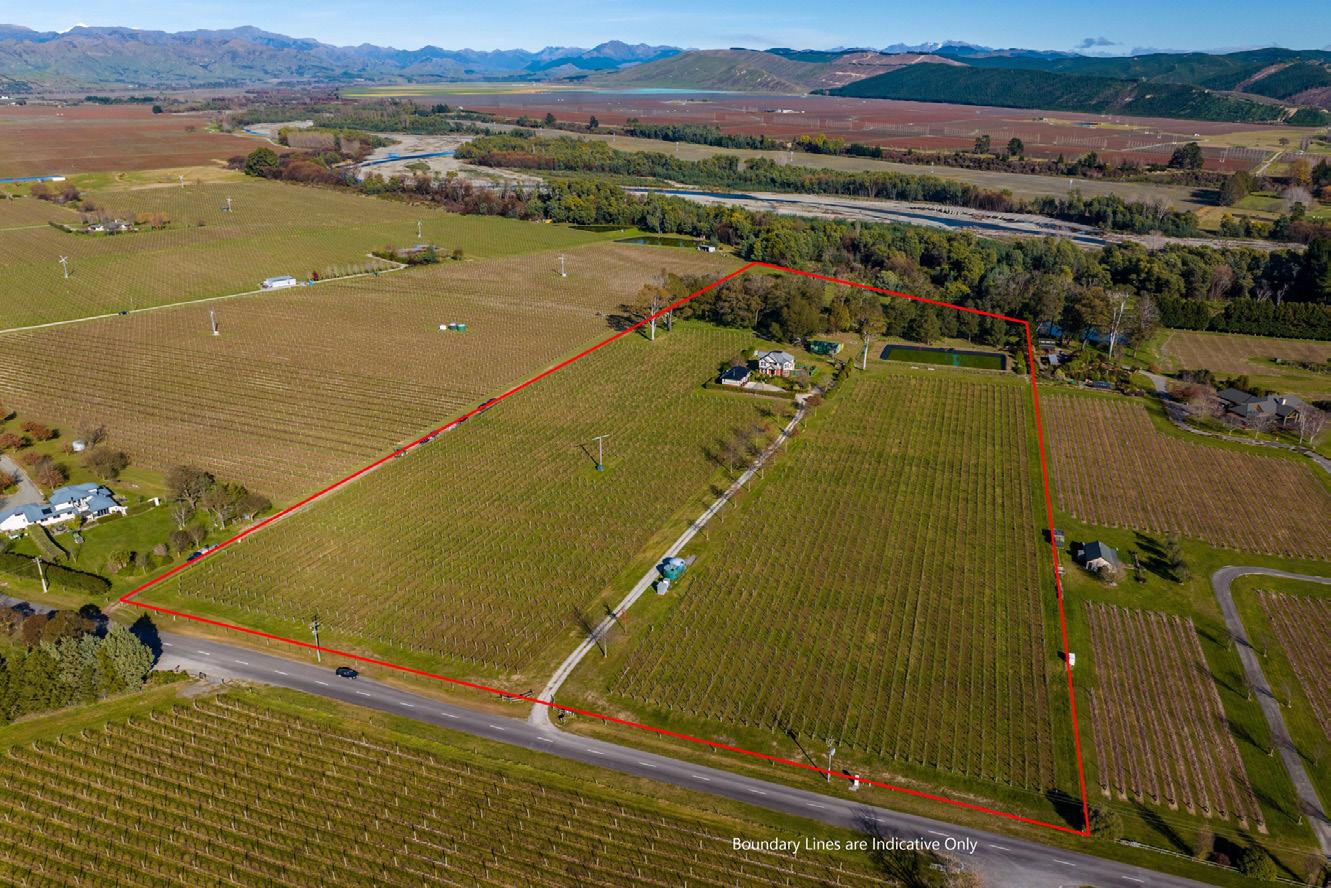

















12
Celebrating Marlborough
Plans to celebrate 50 years of Marlborough Wine will align with a new industry brand, building a visual identity that highlights the uniqueness and story of the Marlborough wine region.
14
Workforce Planning
A National Workforce Survey will provide a ‘stocktake’ of the roles and skills integral to Marlborough’s wine industry, “to get a sense of what skills are being looked for, and what future skills and roles we need”.


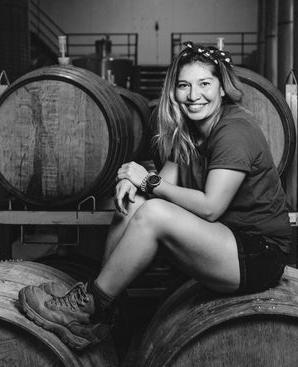
20
Geographical Indications
The Marlborough Winegrowers Board is looking for feedback on Marlborough’s Geographical Indications boundary, five years after its establishment.

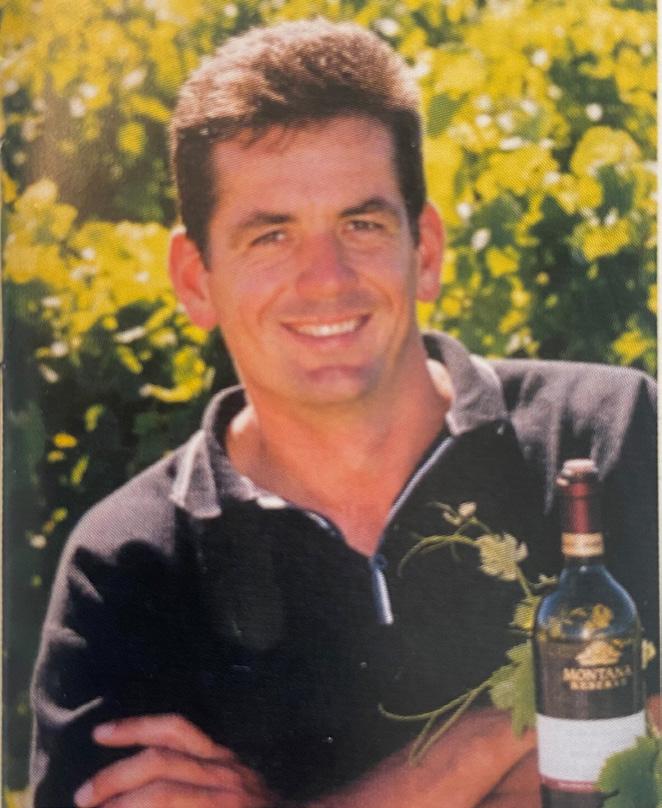








General Manager:
Marcus Pickens 03 577 9299 or 021 831 820 marcus@winemarlborough.nz
Editor:
Sophie Preece 027 308 4455 sophie@sophiepreece.co.nz
Marketing and Communications: Sarah Linklater 021 704 733 sarah@winemarlborough.nz
Events Manager: Loren Coffey loren@winemarlborough.nz
Advocacy Manager: Nicci Armour advocacy@winemarlborough.nz

Advertising: Joanna May advertising@winemarlborough.nz
Grape Grower Directors:
Andrew Nation nationa@gmail.com
Anna Laugesen anna@craiglochart.co.nz
Michiel Eradus michiel@eraduswines.co.nz
Nigel Sowman nigel@dogpoint.co.nz
Tracy Johnston tracy@dayvinleigh.co.nz
Wine Company Directors:
Beth Forrest beth@forrest.co.nz
Damien Yvon damien@closhenri.com
Gus Altschwager gus@akwines.net
James Macdonald james@hunters.co.nz
Jamie Marfell Jamie.Marfell@pernod-ricard.com
Designed by: Blenheim Print Ltd 03 578 1322
Disclaimer: The views and articles that are expressed and appear in Winepress are entirely those of contributors and in no way reflect the policy of the Marlborough Winegrowers. Any advice given, implied or suggested should be considered on its merits, and no responsibility can be taken for problems arising from the use of such information.
This document is printed on an environmentally responsible paper, produced using elemental chlorine free (EFC), third party pulp from responsible sources, manufactured under the strict ISO 14001 Environmental Management System and is 100% Recyclable.
HAPPY BIRTHDAY Marlborough Wine! You’re looking pretty fantastic given your years – what other wine region in the world can claim such global recognition in such a short period? Half a century is a flash in the world of wine, yet Marlborough’s stellar success in that time – driven by its striking Sauvignon Blanc, its passionate people, its audacious innovations, and its extraordinary places – has been monumental.
“It’s only happened to a few wine regions of the world, like Chardonnay and Pinot from Burgundy, or Cabernet and Merlot from Bordeaux,” said Hunter’s winemaker James Macdonald in the August edition of Winepress. “Sauvignon Blanc comes from Marlborough. It’s so special and it’s so rare in the wine world, that we really do have to thank our lucky stars.”
What better way to celebrate a milestone birthday than with a little makeover? On August 24, half a century after Montana planted a vine to symbolise its bold move to Marlborough, a new brand identity was launched to celebrate the people and places that have made Marlborough Wine such a success, while looking forward at continued success for generations to come. As well as a brand to encapsulate Marlborough Wine, the new roll out includes a 50 Year mark, to help companies celebrate their stories with the rest of the world.
August 24 also saw the launch of Tessa Anderson's book – 50 Years; 50 Stories – telling some remarkable yarns about remarkable people who helped put
Marlborough Wine on the world stage. The region’s major milestone, along with its fresh new look, will be under a sparkling spotlight again in November, at The Marlborough Wine Celebration – honouring 50 years, where two Marlborough Wine Lifetime Achievement Awards will be revealed, the trophy winners from the Marlborough Wine Show, sponsored by QuayConnect will be awarded, and industry members – from pioneering leaders to up the up-and-coming talent will celebrate together.
Chief Judge Stu Marfell says the introduction of three subregional trophies recognises an important part of Marlborough’s maturing story. “We want to tell everyone about them, and we want everyone to be excited about trying those wines.”
“What better way to celebrate a milestone birthday than with a little makeover?”

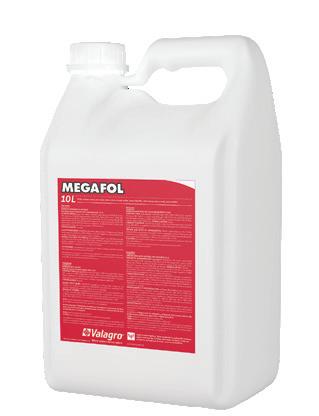
IT IS vital that employers, including winegrowers, integrate human rights policies and practices into their day-to-day business operations. That was a key message at the recent New Zealand Ethical Employers (NZEE) conference, where I discussed human rights as a core part of ‘brand value’ and a company’s social licence to operate.
The July conference was designed to help employers think ‘over the horizon’ in anticipating developments and supporting leaders to be responsive to the changing working environment. It included the launch of two new resources, beginning with our Workforce Planning Framework, which provides NZEE members with tools, resources, and templates to effectively source and retain an optimal work force. We also presented our Human Rights Due Diligence Framework, a practical guide to ensure human rights are embedded throughout your business.

 Tanya Pouwhare
Tanya Pouwhare

We need to build more organisations that prioritise the care of human beings. By investing in their employees, communities, and the environment, businesses can build long-term value and resilience that contributes to their financial success in the long run.
Failures to respect human rights within a company’s own operations and supply chain will negatively impact business viability and consumer and customer trust. No company wants to be labelled an abuser of human rights. The occurrence of modern slavery and worker exploitation, both globally and within New Zealand, represents grave forms of exploitation, and addressing these practices requires a whole-of-society response.
In the coming year, we should anticipate an ongoing sense of urgency as we strive to meet the ever-shifting and increasing consumer, community and government
Megafol has proven plant phenomic and gene response data which shows Megafol switches on over 127 plant genes relative to stress and activates plant responses to mitigate environmental stresses.
expectations. Our role at NZEE is to keep members abreast of these changes and demands, and provide advocacy, support, and guidance to help you navigate what comes down the line, to minimise surprises, and support good decision-making.


The NZEE conference served as a platform for employers to explore ways they could empower human rights and fairness in their workplace. The emphasis on open discussions and Q&A sessions allowed participants to actively engage with the topics and presenters, creating an environment conducive to learning and collaboration, and an understanding of how to bring that experience back into their own space of business.
The conference was an opportunity to introduce two wine partners in NZEE, with major players Indevin and Pernod Ricard joining other non-wine organisations Veges New Zealand and Craigmore. The partnership model allows organisations to showcase their proactive risk mitigation approach, reinforcing their status as socially responsible businesses. This partnership further enhances their reputation and appeal to conscious customers worldwide, and we look forward to welcoming other wine companies soon.
I also attended the Recognised Seasonal Employer (RSE) scheme conference in early August, which was a bit lost in amongst a new Horticulture Conference Week, with a predominant focus on the horticulture sector,



including apples and pears, vegetable product groups, and strawberries. The RSE conference primarily focused on policy and strategy discussions related to both New Zealand and Australian labour mobility schemes, with some Pacific strategy and cultural competencies topics included.
The presenters shared valuable insights, and their expertise and passion ensured attendees gained meaningful knowledge from their presentations. The change of Immigration Minister three times caused delays in the decision-making process of the RSE Policy Review, meaning there was limited opportunity to present up-to-date insights on the much-anticipated review outcome.
Conferences play a vital role in shaping industries and influencing decision-makers. They offer a platform for stakeholders to gather, share knowledge, and collaborate, and can truly become transformative events that shape the future of industries for the better and drive meaningful change.


Tanya Pouwhare is chief executive of New Zealand Ethical Employers Inc (nzee.nz)

Vitaseve is the newest Valagro biostimulant for the NZ Winegrape industry. Vitaseve improves cambium activity and promotes optimal water transportation inside the lignification layer of the vine, increasing vine resilience and reducing vine death.
August 1996, with a mean temperature of 7.7°C, to find a cooler August. August 2022 mean temperature of 10.4°C was 2.6°C warmer than August 2023.
There were 8 air frosts in August 2023, compared to the LTA of 3.5. This is the highest number of air frosts since August 2004, when 10 were recorded.
There were 20 ground frosts in August 2023, compared to the LTA of 10.2. The most ‘recent’ year to have recorded 20 ground frosts in August was 1972 (51 years ago). We have to go back to 1959 (64 years ago) to find a year with a higher number of ground frosts in August, when 22 were recorded.
The coldest air minimum (air frost) temperature of -1.6°C was recorded on 11 August. This was the coldest air frost of winter 2023 (June, July, August). The coldest ground minimum (ground frost) temperature of -5.2°C was recorded on 3 August. This was the coldest ground frost of winter 2023.
1GDD’s Max/Min are calculated from absolute daily maximum and minimum temperatures

2GDD’s Mean are calculated from average hourly temperatures
The mean temperature of 7.8°C was 1.4°C below the long-term average (LTA) temperature for August of 9.2°C (1986-2022). We have to go back 27 years to
It is interesting to compare the average August ground frost temperatures in 2023, 1985, and 1972. Although these years recorded almost the same number of ground frosts, the mean ground frost temperature in August 2023 was not as cold as it was in previous decades (Table 3).
August recorded 233.0 hours sunshine, 126% of the LTA. This is now the second highest August sunshine total on record over the 94 years 1930 to 2023. Only two hours behind the highest total of 235.0 hours recorded in August 2011. Total sunshine for Blenheim for the eight months January to August 2023 was 1547.6 hours, or 97% of the LTA of 1591.3 hours.
Total rainfall during August of 24.2 mm was 38% of the LTA of 63.2 mm. This is the lowest August rainfall total since 2014, which recorded 9.6 mm. It is the 10th lowest August total on record from 1930 to 2023.
Total rainfall for Blenheim for the eight months January to August 2023 was 344.6 mm or 79% of the LTA of 437.0 mm. Total rainfall for Blenheim for the eight months January to August 2022 was 653.8 mm or 150% of the LTA. This is the third highest January to August total on record for the 94 years 1930 to 2023. Figure 1 indicates that the large difference in total rainfall from January to August 2022 and 2023 has only arisen in July and August.
Wind
However, the August mean temperature of 7.8°C was 0.7°C colder than the July 2023 mean temperature of 8.5°C.
Average daily wind run for August 2023 was 190.8 km, 83% of the LTA of 231.1 km. Average wind speed for August was 8.0 km/hr. Blenheim has now had 24 consecutive months with lower-than-average wind-run.
Average daily wind run for August 2023 was 190.8 km, 83% of the LTA of 231.1 km. Average wind speed for August was 8.0 km/hr. Blenheim has now had 24 consecutive months with lower-than-average wind-run.
Winter 2023
The mean winter air temperature of 8.7°C was equal to the LTA. This is the coldest winter since 2015. Winter 2023 was considerably cooler than the previous three winters in 2022, 2021 and 2020.
Table 4 summarises the main weather parameters over the three winter months of June, July and August for the nine years 2015 to 2023, compared to the LTA.
Table 4 summarises the main weather parameters over the three winter months of June, July and August for the nine years 2015 to 2023, compared to the LTA.
The mean 30 cm soil temperature over winter 2023 of 8.3°C, was 0.2°C above the LTA. However, this was due to the soil temperatures in June and July being well above average. The August soil temperature was well below average.
The first two months of winter 2023 recorded well above average mean temperatures; (June 9.7°C was +0.9°C; July 8.5°C was +0.5°C); However, August with a mean temperature of 7.8°C was -1.4°C below average. July should traditionally be the coldest month of winter.
40 ground frosts were recorded over winter in 2023, compared to the LTA of 36.5. Ground frosts in June = 4, July = 16, August = 20. It is interesting to note that the LTA number of ground frosts in August (10.20) is lower than in
The first two months of winter 2023 recorded well above average mean temperatures; (June 9.7°C was +0.9°C; July 8.5°C was +0.5°C); However, August with a mean temperature of 7.8°C was -1.4°C below average.
July should traditionally be the coldest month of winter. However, the August mean temperature of 7.8°C was 0.7°C colder than the July 2023 mean temperature of 8.5°C. The mean winter air temperature of 8.7°C was equal to the LTA. This is the coldest winter since 2015. Winter 2023 was considerably cooler than the previous three winters in 2022, 2021 and 2020.
both June (11.6) and July (14.7). Total number of winter ground frosts in 2023 of 40 is the highest number since 2015, when 41 were recorded.
Total rainfall over winter 2023 of 70.2 mm is 35% of the LTA of 198 mm. This is now the second lowest winter rainfall total on record for Blenheim over the 94 years 1930 to 2023. The lowest winter rainfall of 31.0 mm was recorded in 1969. In dramatic contrast winter 2022 recorded 413.4 mm rainfall, the highest total on record, i.e. 70.2 mm rain in winter 2023 was only 17% of the winter 2022 rainfall of 413.4 mm.
Total sunshine over winter 2023 of 596.6 hours was 120% of the LTA of 496.3 hours. This is now the highest winter sunshine total on record over the 94 years 1930 to 2023. The previous highest total of 595.6 hours was recorded in 1972.



Average daily wind-run over winter 2023 was 192.2 km, 85% of the LTA of 224.9 km.
Given the markedly different winter rainfall totals in 2022 and 2023 the seasonal water balance graph may be of interest to readers. A reminder that the graph plots the difference in rainfall and potential evapotranspiration over a moving 3-month period. At the end of August 2022, the water balance was at +329.7 mm, 245.7 mm above the LTA of 84.0 mm. At the end of August 2023, the water balance was at -12.5 mm, 96.5 mm lower than the LTA. The black LTA line goes from positive to negative on 17 October. The pink line for 2023/24 became negative on 28 August, 50 days ahead of average. With the lack of winter rainfall in 2023, the seasonal water balance line is serving as a warning of what could potentially be down the track in the coming season, without well above average rainfall. if Marlborough heads into a dry spring, then the soil is going to dry out very quickly and irrigation is likely to be needed earlier than normal. With the developing El Nino we should also be prepared for stronger drying westerly winds than we have experienced over the last few years.
ECO TRAINING STAKE is a new innovation designed to replace single use bamboo with a multi-use, sustainable and fully recyclable product that can also be used in conjunction with Klima and other vineyard machinery.
Why ECO TRAINING STAKE?
• Marlborough is beginning their redevelopment cycle and utilising reusable stakes is cost-effective as vineyards only need to buy their stakes once, then they can reuse them multiple times.
• Vineyards around the world are becoming more automated and mechanised and uniformity to the vineyard plant trunk is key. By keeping vineyard stakes in the ground for three to four years the vine trunk will grow straight and aligned with your trellis.
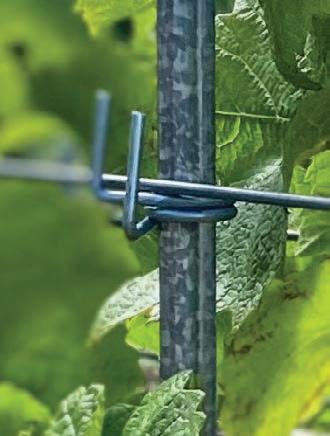

• The ECO TRAINING STAKE is fully recyclable.
• ECO TRAINING STAKE aligns with the wine and viticulture industry sustainable grape growing practices.
• A solid stake protects young plants from cultivators.
• There is a clip option available for using Klima Pruning Machines.
AS MARLBOROUGH entered its third decade of wine, iwi were among those investing in the burgeoning industry. In October 2000, Ngāi Tahu spent more than $9 million acquiring 69 hectares of vineyards and land to supply Giesen. The following year, Nelson-based Wakatū bought 120ha in the Awatere for its Tohu label.
In February 2001, Marlborough winemakers – frustrated by increased cork taint impacting wine quality – identified the screwcap as the most promising alternative. The Screwcap Initiative they launched was adopted world-wide. The International Screwcap Symposium was held in Blenheim in November 2004, and by the late 2000s around 30% of the world’s wines were sealed by screwcaps.

In 2002, Lion Nathan purchased Wither Hills from Brent and John Marris for $52 million, and the following year Brent Marris established a large vineyard in the Waihopai Valley. The same year Peter Yealands bought 125ha in the Awatere Valley, in the first stage of what would soon become a 1,000ha vineyard.
In 2004, the Southern Valleys Irrigation Scheme began to provide water to 4,500ha to the south of Renwick, opening up new land for vineyards. Water was sourced from the Wairau River immediately below the confluence with the Waihopai River, with minimum flows established. The same year the Wither Hills vineyard at Rarangi was given consent, with conditions, to take water from the Rarangi aquifer.
In 2005, Ormond Nurseries developed a modified net winder to remove nets before harvest, able to be operated by one person. In September 2006, The New Zealand Wine Company, producer of Grove Mill wines, became the first carbon neutral certified winery in the world. The Recognised Seasonal Employer (RSE) scheme began in 2007, allowing 5,000 Pacific workers into New Zealand for seasonal work, including in Marlborough’s expanding viticulture sector.
KLIMA was established in 2008 by viticulturists Nigel George and Marcus Wickham as a highly-efficient vineyard pruning system. The following year, Renwick-based Walter Langlois developed machines for stripping. By 2009 the Global Financial Crisis had seen Sauvignon Blanc grape prices fall from $2,400 a tonne to half that, or less. There were calls to reduce production amid a glut, but the alarm didn’t stop Cloudy Bay’s former winemaker Kevin Judd from establishing his Greywacke label.
In 2010, RSE worker numbers were reduced due to cost-cutting by wine companies. Some, including Awatere Vineyards Holdings and Gravitas, went into receivership. The decade concluded with new council rules in Marlborough on the location and noise levels of an increasing number of frost machines. That year Yealands was judged to have the most environmentally-pioneering winery in the world.
“Who would have thought at the beginning of 1973 that the planting of a few grape vines in Marlborough would turn the wine world upside down?” That’s the question posed by Tessa Anderson’s new book, 50 Years; 50 Stories – Marlborough, the region that turned the wine world upside down, as it celebrates the people, places and innovations behind an extraordinary success story.
This fantastic book by the former editor of Winepress and Winegrower Magazines is as much a testament to Tessa’s incredible attributes as it the region’s. It was completed in the wake of a serious stroke that would surely have seen most people shelving the project. Instead, Tessa dug in to produce 50 stories that reflect the challenges tackled and opportunities embraced by those in the industry over the past half century. To get a copy, go to ratapublications.com And to hear Tessa talk about the book at the 2023 Marlborough Book Festival, check out the latest Marlborough Wine Podcast at marlboroughwinenz.com/podcast.
Patrick Materman began wine work in 1990, riddling Montana’s first release of Deutz Méthode Champenoise, a blend of Chardonnay and several ‘Pommard’ and Swiss Pinot Noir clones. Little did Patrick realise that within a few years he’d be overseeing the production of quite possibly more Pinot Noir than any other winemaker in the world.
Andy Frost, Patrick’s colleague at Montana, first produced a Montana Pinot in 1989, using clones that proved more suited to sparkling wine. It didn’t take off, but by the early 1990s the red revolution was already fermenting. People like Mike Eaton (Clayvin) and Hätsch Kalberer (Fromm) were trying different clones on sites that included the southern valleys off the Wairau Plain.
Patrick recalls a lot of Pinot Noir excitement in the Marlborough winemaking community, even though most of their time was devoted to the region’s star. “Sauvignon Blanc is mostly made and sold as a fresh, bright wine with less winemaker influence. Winemakers get deeply passionate about Pinot Noir as a variety – they like to stamp their own style.”
Patrick Materman on the cover of Montana’s newsletter in 1999, after the Montana Reserve Pinot Noir took a trophy at the Sydney Top 100. The newsletter also discussed recent expansion of Marlborough Pinot Noir plantings, which would continue unabated into the 2000s.
Patrick Materman on the cover of newsletter in 1999, after the Reserve Pinot Noir took a trophy at the Sydney Top 100. The newsletter also discussed recent expansion of Marlborough Pinot Noir plantings, which continue unabated into the 2000s.
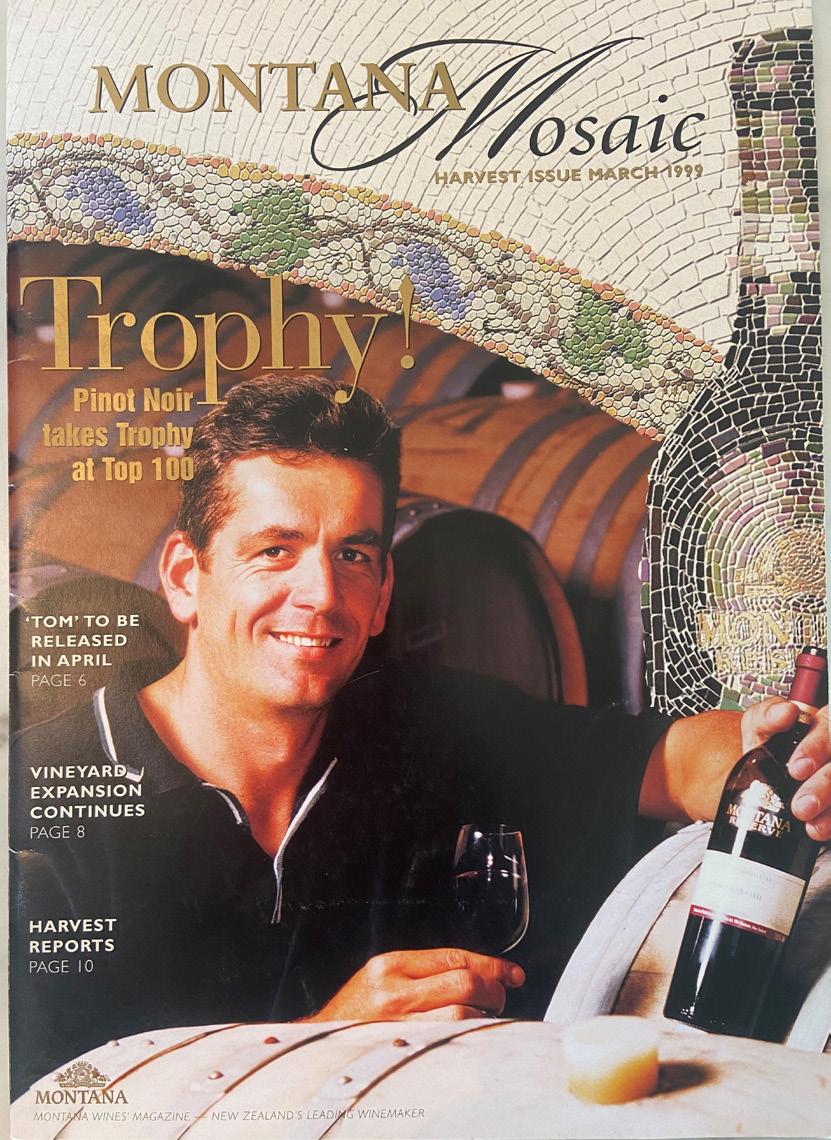
There were annual Southern Pinot Noir workshops in Hanmer Springs (which continues) where Marlborough winemakers from the likes of Villa Maria, Cloudy Bay, Nautilus, Hunter’s and Auntsfield mixed with other New Zealand Pinot producers, doing comparative tastings and swapping information. “I’m trying to think of another industry where direct competitors get together to share knowledge to develop a better product,” Patrick says.
By this time, Montana was producing a Reserve Pinot Noir, selling for around $25 – the minimum wage then was $7.70 and it’s now $22.70, so that’s closer to $70 in today’s prices. In 2001, Montana released what this wine reviewer then billed ‘Pinot Noir for the masses.’ This admittedly lighter bodied, but still appealing and drinkable wine, sold for as little as $11.
To achieve this, the company had planted significant areas of Pinot Noir at its new Kaituna and Squire vineyards and replanted some of its Fairhall blocks. Montana also planted 40 to 50 hectares of Pinot Noir at Seaview in the Awatere Valley, and at the Terraces Block in upper Brancott Valley. “That was the first of the Dijon clones, which in time drove greater depth of flavour and complexity to the wines,” Patrick recalls.

Before long, Montana had more than 300ha of Pinot Noir planted in Marlborough and was crushing 3,000 tonnes, creating speculation at the time that it could be the world’s biggest producer. Also expanding were others like Delegat and Villa Maria, with its Seddon and Taylors Pass single vineyard Pinot Noirs, which Patrick observes have been a standout.
Between 2003 and 2008, Damian Martin led the development of 90ha of Pinot Noir in high density plantings at Ara Vineyard on Bankhouse Station, which was the largest single planting of Pinot Noir in the country. With Bankhouse Vineyard now under Indevin Group ownership, it remains the largest single Pinot Noir planting in the country, and a site Patrick is thrilled to be working with as their director of winegrowing.
Marlborough’s Pinot Noir plantings grew rapidly from less than 500ha in 2000 to more than 2,000ha by the end of the decade. However, with more certain demand for Marlborough Sauvignon Blanc, the planting of Pinot Noir slowed.
Wineries also faced huge investments in smaller tanks, open-top fermenters with plunging systems, and oak barrels, as well as swings of up to 40% in yield, with early-ripening Pinot Noir facing more frost and flowering risk. This, coupled with highly manual vineyard practices, are reasons few growers have chosen to produce the challenging variety, Patrick says.
From around 2003 onwards, the focus increasingly went on quality, developing subregional expressions. Marlborough’s distinct red fruit style, aided by the region’s more bankable climate, still sees its 2,637ha produce about half of New Zealand’s Pinot Noir. Viva la revolution .
“MARLBOROUGH WINE is the perfect fusion of people, place, passion, and perseverance.” That’s one of the messages behind a new Marlborough Wine brand identity, which encapsulates the myriad attributes that make the region – and its wine – extraordinary.

Wine Marlborough Ltd launched the refreshed brand identity on August 24, 50 years after Montana held an official planting of its first vines in the region, and managing director Frank Yukich declared that “wines from here will become world famous”. The new brand celebrates that past – recognising the wine experience, talent, innovation, and reputation built by passionate people in a unique place, while also sharing excitement about the future. “As the region that first put New Zealand wine on the world map, we continue to define the pulse of wine in Aotearoa,” it says. “We are fearless and forward-looking. We have earned our place in people’s hearts, and will continue to do so for generations to come.”
Marlborough Wine marketing and communications manager Sarah Linklater says the ambition was to
The curving lines on the left side of the brand mark represent the Wairau, Waihopai, and Awatere rivers. On the right, the lines are Awatere, Wairau, and Southern Valleys
streamline, simplify and strengthen the messaging around Marlborough Wine, including tools and a logo wine companies can use to celebrate 50 years, and “activate their stories”.
The branding work has been built on insights from a Marlborough Wine survey, which drew a strong response from members, keen to both celebrate Marlborough’s ‘hero variety’ as well as the complexity and layers behind the region’s full wine offering, while reflecting the people and place that have driven its success. “From the Southern Valleys through to Wairau Valley and onto the Awatere Valley and Southern Marlborough, our diversity is epitomised by the many craftspeople who capture wines that are impossible to imitate, hard not to love and filled with passion and provenance.”
To read more on the brand and find toolkits to activate your own stories, go to marlboroughwinenz.com/marlboroughwine-brand
THE MARLBOROUGH Wine Celebration – honouring 50 years, will bring together an industry that’s passionate about its past and its future.
Two of the region’s wine pioneers will be recipients of the Marlborough Wine Lifetime Achievement Award at the special evening event on November 17, while trophy winners from the Marlborough Wine Show, sponsored by QuayConnect, are put in the spotlight, including winners of the Legacy Award and three new subregional trophies.
Winemaker Stu Marfell takes over as chief judge in this year’s competition, and is excited about the move to trophies for wines from the Awatere Valley, Wairau Valley and Southern Valleys. The long-running show has long had a focus on the unique attributes of its subregions, helping to tell Marlborough’s story. “It is easy to think of Marlborough as just this one big region, but when you start drilling down you know we’ve got these really distinct subregions. We want to tell everyone about them, and we want everyone to be excited about trying those wines.”
Stu says the wine show is a wonderful opportunity for Marlborough producers to benchmark their wines against others in the region. It’s also an important event for nurturing new judges. “I have got a lot of benefit from all the years I have been judging, and learning from some of the older judges involved,” Stu says. “Hopefully I can now pay that back to some of the new people coming through.”
This year the judges include Stephen Wong MW, along with another yet-to-be-named guest judge, assessing wines from October 18 to 20. There’s also a “pretty special” guest
judge coming in to help assess the Legacy category, which is won by the wine producer with the highest scores for three vintages of the same variety over a 10-year period. The award, which is allocated a separate day of tasting, is an emblem of a maturing region, able to produce extraordinary wines of longevity, across a range of varieties. “There are wines of Marlborough that are drunk early but there are a lot of wines that age amazingly well,” Stu says.
Last year the Marlborough Museum Legacy Award was taken out by Wither Hills Taylor River Single Vineyard Pinot Noir 2019, 2015 and 2011, but there was tough competition from other varieties, including an “outstanding” flight of Chenin Blanc, and Sauvignon Blanc that shone through with age, Stu says. The Legacy Award judging is a great opportunity for high profile guest judges to see what Marlborough can do. “It’s really exciting to show them the strength of these wines, and get them buzzing about Marlborough, and hopefully spreading the good word.” marlboroughwineshow.com


complete
Ideal for use in the vineyard via drip lines or as a foliar spray, and available in any quantity from 20 to 2000 litres in a single delivery to your preferred site.
www.torychannelkelp.co.nz | 027 445 3708 | sales@torychannelkelp.co.nz

A STOCKTAKE of the roles required by the regional and national wine industry will help Marlborough plan for ongoing labour challenges. That’s the perspective of the Marlborough Wine Industry Workforce Steering Group, which has commissioned a National Workforce Survey, to be rolled out from September 25.
Marlborough Wine advocacy manager Nicci Armour says the survey will analyse the roles and “skill clusters” involved in growing, producing, bottling, marketing, selling and transporting wines – from social media experts to winemakers, and from accountants to viticulturists –providing an evidence base for planning the future of the workforce. It will also include big data analysis of wine industry roles advertised globally, “to get a sense of what skills are being looked for, and insight into the future skills and roles we need”.
The wine industry’s continued growth in Marlborough – paired with a global skills and labour shortage, a small population, and “very low unemployment rate” – has resulted in an ongoing challenge to ensure businesses have the talent and people they need, Nicci says. “Our industry is not just run in the winery and the vineyard, but in the likes of marketing, human resources, finance, and sales. We want to get a clear sense of what is needed to support business.”
Steering group member Ryan Glover, national vineyards manager at Delegat, says wine is a “people-driven industry”, and workforce planning, including training and career development, is integral to its success. “If we want to grow, we know we need lots of talented, experienced, energetic, good, enthusiastic people.” There is going to be a lot of competition from industries around the country for those skills. “Everyone wants those people, so how do we identify who we need and make it attractive for them to come and work for us?”
Ryan says workforce shortages impact everyone from contractors to “mum and dad operations”, growers to small wine companies. “We all have a pretty good gut feel of where we think problems are and what those shortages are. But when we got people in the room for the steering group it became obvious that … we were all looking at it in
a different way – and our requirements were different.” The survey project will offer a data-based perspective, “so we can articulate what that problem is or where those shortages are”.
The project, to be delivered by BERL (Business and Economic Research Limited), will survey industry members across new Zealand, as well as companies integrally linked to wine, such as bottlers, labour contractors, and steel fabricators. “So, it’s quite an all-encompassing piece of work, particularly for Marlborough,” Nicci says. “We want to understand any potential bottlenecks or risks to the industry. The project will also help us better understand career and development pathways.”

The analysis will group skill requirements and how they apply within the one industry, Nicci explains. That in turn will help inform the education and training sector, by offering insights into the skills required for the future success of the wine industry, beyond winemaking and viticulture.
The steering group was established in 2022, “because we could see labour supply – both permanent and seasonal – was already creating an issue for businesses”, Nicci says. “It was not going to be a quick fix after Covid.” Over the past 12 months the group has identified “immediate priorities”, such as workforce wellbeing – leading to the inaugural Marlborough Wine Industry Wellness Week in May this year. It is also working to support a culture of leadership and professional development.
Results from the survey are to be reported back in May 2024, after the busy vintage period, and will provide a backdrop to future workforce planning in Marlborough, Nicci says. “We’ll share all the learnings with the other regions, who will be able to use the data and insights to inform their own workforce plans.”
The project has received $60,000 from the Ministry of Business, Innovation and Employment’s Sector Workforce Engagement Program, which sits under Kānoa, the Regional Economic Development and Investment Unit. It has also received funding from New Zealand Winegrowers. marlboroughwinenz.com/workforce-plan
Sustainably recycle your end-of-life dripline into posts for use in vineyards and farms

Purchase Rivulis industry leading dripline for your replacement programme and receive a pre-paid voucher* to recycle any brand of dripline at Future Post’s facility in Blenheim. Install 100% recycled Future Posts back on your vineyard to fully close the loop while also improving your time and cost saving measures by utilising an extremely durable, CCA free post.
To find your local dealer contact Water Supply Products: Auckland: 09 916 0094 | Christchurch: 03 348 1293 wsp@watersupply.co.nz | www.watersupply.co.nz
Future Post contact details: www.futurepost.co.nz
info@futurepost.co.nz | Head Office: 09 238 0199
DDI vineyard: Diana Jamieson 021 447 725
* Conditions apply. Please ask your local irrigation reseller for further details.
BETWEEN THE pandemic and low unemployment rates, New Zealand’s winegrowers have been hit hard by the tight labour market in recent years. And it’s only expected to get tighter, according to Tanya Pouwhare, chief executive of New Zealand Ethical Employers (NZEE).

The seasonal time pressures of vintage and winter pruning only adds to the tension, Tanya says. “By 2030, there will be an estimated global talent shortage of 85 million people – we are already feeling it right now, with
globe, and the competitive edge that comes from doing it right. We’re seeing a ‘new normal’, with greater trust, accountability and transparency being demanded by consumers globally. There’s a big opportunity for New Zealand exporters to leverage this awareness and position themselves as an attractive place to work and a producer of a premium product that doesn’t compromise the health and wellbeing of its employees.”
As part of its work, NZEE supported its members with
slowing population growth, loss of skilled workers overseas and the higher average age in Marlborough.”
During her keynote address at the Annual Pacific Labour Mobility Meeting late last year, Tanya covered a range of strategic opportunities the industry could pursue to shore up the labour gap in the coming years. As well as understanding the efficiency gains of embracing technology, she highlighted the need to expand the geographic and gender diversification of the labour force and increase workforce capacity by training and upskilling in New Zealand and the Pacific.
In a world that is becoming increasingly aware of racial prejudice and discrimination, it was important for the Government and industry stakeholders to collaborate and continue to improve working conditions to not only protect employees but also New Zealand Wine’s reputation as an ethical and sustainable employer, she says. “There’s an increase in the awareness of human rights around the
ways in which to be more inclusive, including flexible working hours, being a disability confident employer and having a workplace that is worker friendly, from tech-savvy younger crew to staff more senior in years. Making changes to become a more diverse workplace takes a considered and committed approach with input from the entire organisation, she says.
Vineyard management and labour supply company Hortus is just one Marlborough business that has experienced the pinch of the tight labour market and in recent years have had to “think creatively” to recruit and retain staff. Hortus people and culture manager Lucy Maclean says by adapting roles to suit individual needs, rather than creating cookie cutter job descriptions, there is potential to embrace a wider pool of employees, including senior workers and people with disabilities. “Ultimately if a role can be shaped to fit someone who is hearing impaired or has a physical disability - why not? There is increased
With its aging population and rates of immigration set to increase, the face of New Zealand’s workforce is going to evolve. KAT PICKFORD talks to some key players on the front foot, ensuring their workplaces welcome, nurture and celebrate the change.One of the cellar images taken as part of a winery recruitment campaign in Marlborough. Photo Richard Briggs
“By nature, winemaking is a diverse industry, so if businesses can create workplaces that are welcoming to all, then they are going to be well prepared for the future.”
Nicci Armour
GREG
Let's help Hawkes Bay farmers rebuild their fence lines today

We repurpose your broken vineyard posts by grading them, removing nails, clips and plastic, cutting them to size and then bundling them up ready for farmers' fence lines.
Countless wineries have already become part of this sustainable solution, allowing farmers to fence 3,530km of Kiwi land to date.

Our fees are cheaper than landfill costs but, more importantly, your business will be decreasing your environmental impact, by reducing your viticulture landfill waste. Contact us today – it's a no-brainer!



6.
7.
recognition now about the strengths of neuro-diversitypeople with dyslexia for example are known to be great problem solvers and outside-the-box thinkers.”
From annual celebrations to multinational festivals, an internal analysis of the gender pay gap, and looking at ways to reduce waste, many of the company’s initiatives have begun at ground level, through staff asking questions and starting conversations, Lucy says. Hortus employs about 1,300 Recognised Seasonal Employer (RSE) scheme workers and 200 international backpackers each year.
But a diverse workforce will not be successful without a culture of inclusivity, in which everyone feels safe, respected and seen, Lucy says. “We put in a lot of work to create an inclusive environment for all our staff … Feedback is welcomed, and everyone has an opportunity to be heard.”
Marlborough Wine Advocacy Manager Nicci Armour applauds the work businesses such as Hortus are doing to stay ahead of the game. “Part of the workforce planning Marlborough Wine is doing is looking at the changing

demographics to gain a deeper understanding of what lies ahead and at an industry level to front foot any challenges and look at the opportunities within those challenges.”
Workplace initiatives showcased by wineries during the first Wine Industry Wellness Week in May, showed many companies were well on their way to creating a diverse and inclusive work environment, Nicci says. “As we know, diversity and inclusion in the workplace can have a huge positive impact on business … By nature, winemaking is a diverse industry, so if businesses can create workplaces that are welcoming to all, then they are going to be well prepared for the future.”
Tanya says building inclusive, sustainable, and diverse organisations demands new ways of thinking. “It will not be a matter of wanting to have a diverse workplace, but a matter of having to,” she says. “What worked in the past, won’t work in the future.”
Pernod Ricard Winemakers was presented with the Inclusive & Diverse Workplace Award at the 2023 Australian Drinks Awards last month. The judging panel unanimously favoured the Pernod Ricard Winemakers’ campaign aimed at enhancing the adoption of flexible working arrangements and parental leave among males within its organisation. In its submission, the company said it was clear that encouraging men to take parental leave and utilise flexible working arrangements helps “remove the stigma of men being active fathers and the barriers to career progression faced by women”. The implementation of PRW’s targeted awareness campaign and policy improvements resulted in an impressive 25% increase in males taking parental leave over a two-year period.
SOPHIE PREECE
Wither Hills canned the “cookie cutter” approach to employing winery workers during Covid-19, says head winemaker Matt Large. “In the past three years we have been a lot more diverse and a lot more open to where we look.”
The Marlborough wine company traditionally called on a crew of overseas cellar hands for vintage, making up 75% of their short-term workforce, with the remaining 25% largely backpackers on holiday work visas. When those sources dried up during the pandemic, they looked outside the box and found a rich resource of workers, including travellers of a different sort, with campervan dwellers driving in for the harvest period.
Some of them are retired and looking for work, and others are simply looking for a change. “Last year we had a couple who thought life was too busy in their day jobs. They packed up the house to rent out for a while and bought a caravan to do the seasons.” Some will follow their Marlborough vintage with winter work somewhere else, then cherry picking in Central Otago, before returning to Wither Hills,” Matt says. “For us it has been about being a lot more open to all sorts … broadening our horizon.”
And they have been rewarded with workers with great life experiences and skills, easily able to turn their hand to cellar roles while fitting in smoothly with the company’s culture. “The easiest thing to do is to train someone to be cellar hand. We’re looking for nice people who are team players, which is something you can’t train,” Matt says.
Last year Lion was a finalist in the Inclusive Workplace category of the Diversity Awards NZ, and a finalist in the Deloitte Top 200 Awards for Diversity and Inclusion Leadership, acknowledging its ambitious goals around a genderbalanced, inclusive workforce. At the time, Lion New Zealand managing director Craig Baldie said diversity and inclusion was not simply about ‘doing the right thing’. “It is critical to the long-term success of our business. To deliver the best products, services and experiences for our customers and consumers we need our internal workforce to reflect the demographics of the markets we operate in.”
Matt says at Wither Hills the ethos is “very much about employing for the position regardless of gender or ethnicity”, and women make up more than half of the positions at the Marlborough winery. The parent company’s approach to flexible hours has also been readily adopted at the site, with the winery team able to tap into skills they might not otherwise be able to access. Lion had developed its LionFlex policy several years before Covid-19, and it’s been useful in recruiting workers with good skills but limited time, including parents with young children wanting to return to work, says Matt. “This year we employed a permanent cellar hand with a later start and earlier finish. She had some good skills, but as a parent she required different hours. We were happy to make it work for her. We are open to looking beyond the cookie cutter.”
Meanwhile, he says plenty of overseas workers have been eager to come to New Zealand to work in wine, although the cost is prohibitive for some these days. “I think what we did over Covid by trying to protect our people maybe resonated with people who want to come to New Zealand … We’re seeing no shortage of foreigners wanting to come here to work.”



New Zealand agent for Netwizz and Olinet netting applicators. Slim, standard and hydraulic mast models available.

“The easiest thing to do is to train someone to be cellar hand. We’re looking for nice people who are team players, which is something you can’t train”
Matt Large
THE MARLBOROUGH Winegrowers Association Board is looking for feedback on Marlborough’s Geographical Indications boundary, five years after its establishment.
Marlborough achieved its New Zealand geographical indication (GI) in 2018 under The Geographical Indications (Wine and Spirits) Registration Act, which came into force in 2017. “In the lead up to that registration we consulted widely with members and New Zealand Winegrowers (NZW), to determine the lines we would draw to define Marlborough wine,” says Marlborough Wine general manager Marcus Pickens.

“Protecting the name Marlborough was the primary task, giving our winegrowers confidence in the integrity of that global brand. That meant considering what area would and would not fall within the definition. The result of those discussions was an inclusive area, with a southern boundary below Kaikōura and north to encompass the Marlborough Sounds.”
Five years on, it may be appropriate to look back at those conversations and discuss the reasons the boundary line was set, Marcus says. “We are keen to know whether there is widespread support amongst the Marlborough wine industry to delve back into the discussion and retest the decisions made by members in 2017.”
The GI means only wine from Marlborough may use that reference, and a wine with less than 85% of Marlborough fruit cannot use Marlborough on its label, even as part of a brand name.
The GI Act also reiterates that a wine may only bear a registered New Zealand GI if all of the grapes used are New Zealand grapes (see Q&A on page 24).

Matt Thomson and Sophie Parker-Thomson MW are keen to revisit the GI area, saying the current boundary threatens the investment of winegrowers in areas that built the region’s global reputation. The couple behind Blank
Canvas Wines are part of Appellation Marlborough Wine (AMW), which is a member organisation started the same year as the Marlborough GI registration. They are also on the AMW subcommittee that created a wine map of the region earlier this year. That map offers a delineation of Marlborough subregions, with boundaries that stop south of Kēkerengū on the east Coast and at the Wye River in the Wairau Valley. The map does not include areas leading to Picton and Havelock.
Sophie spoke to the Marlborough Winegrowers board earlier this year, asking them to consider the risks of the current GI, including areas that receive more than twice the rainfall of Marlborough’s typical winegrowing subregions.
“There’s real potential for the reputation of the established industry to be eroded by future plantings in areas that will on average provide poorer product,” Matt says. “A GI is about the consistency of typicity. A GI is about: ‘this area produces wines that are recognisable and consistent within that area.’ So how can you say climatically that Kaikōura is like Blenheim?”
He and Sophie believe the best way to guide the GI is to use the rain shadow description mentioned in the original registration. The Richmond Range ‘shadow’ results in low rainfall, of around 640mm per annum, in many of Marlborough’s established grape growing areas, Matt says. The land through to Havelock, Picton and Pelorus, as well as the Kaikōura dairy flats, have rainfall closer to (or above) 1,500mm.
“For me the way forward is to be comfortable with the Marlborough wine appellation as it stands and spend a bit more time thinking about how to divide up the sub appellations within that.”
Simon Waghorn






















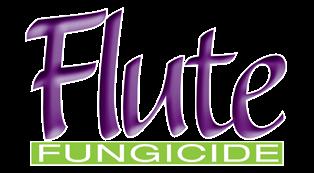








“Our argument is that those areas are quite different to what made Marlborough so famous.”
They believe a GI based on 1,200mm rainfall data as a “hard border” would be generous, and would encompass all the existing plantings on the Northbank. There is a lot more discussion to be had, Matt adds. “But we need to start it. The earlier we do, the less harm, damage and hurt there will be. Marcus notes that the rain shadow was one of many geographic and climatic features considered in the GI consultation and application.
Astrolabe Winemaker Simon Waghorn led a Marlborough Winegrowers Board sub-committee on the GI map in 2008, and remains happy with the boundary, which reflects the historic provincial lines of the region. Despite the relatively recent shift of Environment Canterbury to an area north of Kēkerengū, most people still consider Kaikōura to be part of Marlborough, he says. “We thought it was more important to get a start in the appellation world by having a big catchall boundary and then really focusing more on how we divide that up, which is going to be of a lot more interest for a lot of people as time goes on. What’s Awatere? What’s Wairau? And so on.” The group didn’t think it was worth “picking a fight” with those who would be cut out of a region they’d always considered themselves part of, Simon adds.
The 2008 map was discussed again in 2016, as the GI legislation loomed, with a Wine Marlborough and NZW summit to consider the bid for GI registration. Wine Marlborough proposed a reduced area that ended south of the Clarence River, but participants argued the Marlborough Sounds and Kaikōura were “jewels in the crown” for the region, and questioned why anyone would give up their marketing power.
Five years after the registration, Simon notes that Marlborough’s current wine growing region would have been unfathomable to many in the industry’s early days, and anyone drawing a boundary may have excluded the Awatere Valley, “let alone Blind River”. Into the future other areas may prove to be successful, particularly as climate change impacts grape growing. “I think there’s a lot of

Marlborough that is obviously unsuitable for grape growing and I don’t think is economic for grape growing. But for areas that are yet unplanted within that boundary, I am happy for people to have a go.”
Regarding concerns that companies may look to the likes of Kaikōura to grow high tonnage of grapes, Simon says the greater risk is people carrying “unbridled” crops in what is considered “mainstream Marlborough”. Rather than limiting the Marlborough boundary, he would like to see standards set on low brix and high sugar use. “Some sort of overarching regulatory environment about what they can or cannot do to call something from Marlborough.”
Simon is also part of the AMW map group that has worked to define subregions, which he is excited by. “For me the way forward is to be comfortable with the Marlborough wine appellation as it stands and spend a bit more time thinking about how to divide up the sub appellations within that.”
Marlborough Winegrowers chair Beth Forrest says the board is eager to hear whether there is momentum among members for change. A lot of work went into drawing the lines for the original GI, with its “all-inclusive environment”. Those discussions looked at the future needs of the industry, but the “acceleration of the industry has been far beyond people’s imagination”, she says. And if enough members do want change, “we are absolutely here to investigate avenues for change especially those that secure quality for the future”.
If you would like to offer feedback, please get in touch with a board member. Contact details are on page 3.
“Our argument is that those areas are quite different to what made Marlborough so famous.”
Matt Thomson

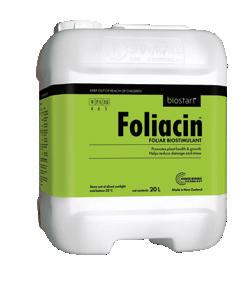
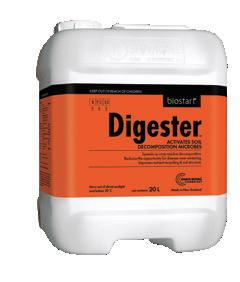




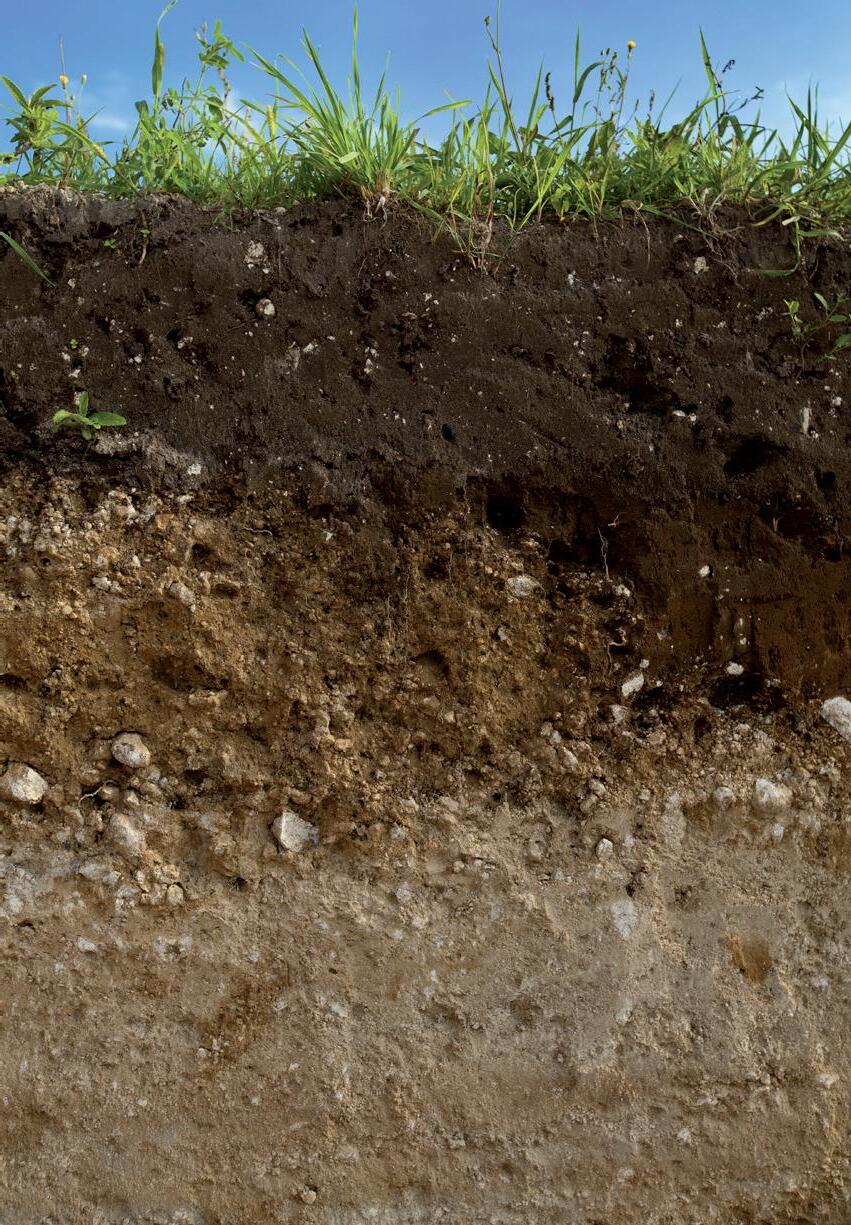





Geographical Indications (GIs) afford winegrowers additional protections when using them on a wine label. While this protection is based in New Zealand, it also extends to some of our export markets (and will extend further under the EU free trade agreement, when it comes into force next year).
GIs are an important part of the New Zealand wine story and New Zealand’s legislation (the Geographical Indications (Wine and Spirits) Registration Act) provides additional protection for GIs over and above other terms used on wine labels.

New Zealand now has 22 GIs for wine. Some of these are automatically protected by law (like New Zealand and South Island), while others have been through an application process and need to be periodically renewed.
The criteria for determining boundaries were set by the Ministry of Business, Innovation and Employment (MBIE), based on the requirements of the legislation and consistent with New Zealand’s international obligations.
The regions each had ownership of their own GI applications. Applications and boundaries were developed based on MBIE’s criteria and on consensus within each region. The applications mostly relied on boundaries that had been used historically (which were, in most cases, political boundaries).
More information on the current criteria is available online at iponz.govt.nz/about-ip/geographical-indications/ practice-guidelines/
Yes, it is possible to alter a GI, although this has not happened in New Zealand to date. To do so, you would need to follow a similar process to the original application. There would be many issues to consider in altering a GI, including possible impacts on international trade, and the potential for opposition by existing users of the GI.
There are a number of subregions that have their own registered GIs. Generally, these are subregions with an established standalone reputation (ie they are not usually referred to in association with a regional GI). For example, Waiheke Island is typically used on its own, and is not commonly referred to as a subregion of Auckland. Almost all of the subregions were registered when the Act came into force; however, we have seen Bannockburn registered as a subregion subsequently. We may well see more in the future. Any subregions wishing to register would need to file a new application for a GI. More information is available on the IPONZ website.
The current New Zealand legislation was not designed to do this, and this reflected New Zealand’s approach in international trade negotiations. It principally controls the origin of the grapes used for winemaking.
Currently, to use a GI, 85% of the grapes that make up the wine must have come from the region(s) named on the label, and 100% of the grapes must be from New Zealand. GIs do not restrict viticultural or winemaking practices, limit varieties and wine styles etc.
The GI legislation is being updated to incorporate changes required by the incoming free trade agreement between New Zealand and the European Union. This will include updates to the register to add European GIs, and enforcement of the GI regime shifting to the Ministry for Primary Industries. New Zealand registered GIs will also be protected in Europe as a result of this agreement. This article is provided as general information and guidance and does not constitute legal advice. While all due care and attention has been exercised in preparing this article, neither New Zealand Winegrowers Inc nor its employees/agents accept any liability of any kind for any loss and/or damage that may arise from reliance on the information presented.
You own your wine company – all growers have a shareholding in MGGC 1
There is transparency on how your wine company is run 2
Profits made by your wine company are returned to you (the grape grower) 3
This wine company is totally focused on your needs 4
MGGC runs a sustainable, low
Meet Mart Verstappen, Marlborough Grape Growers Cooperative’s new Membership Manager.
At the Co-op we are excited to welcome Mart Verstappen to the fold, with his three decades of experience in Marlborough viticulture.
After immigrating to New Zealand from the Netherlands, Mart started his career in viticulture as Nursery Manager for Cloudy Bay Vineyards in 1989. Mart went on into technical management positions for Riversun and Corbans Viticulture, developing vineyards and offering technical advice in all the main grape growing areas of New Zealand.

Later, at Pernod Ricard Winemakers his skills were honed in day-to-day vineyard management roles at the Triplebank and
Stoneleigh vineyards. The subsequent draw to Farmlands Cooperative as Technical Lead for viticulture was instigated by the belief in the importance of building collaborative relationships among grower/farmer shareholders.

Mart is your contact at MGGC should you wish to discuss the benefits of owning your own wine company and becoming part of the community of Co-op ownergrowers.
Ph:
“GIs are an important part of the New Zealand wine story.”
Sarah Wilson

SUSTAINABILITY AND care for the environment has long been “woven into the DNA” of the Grove Mill brand and its people, says assistant winemaker Zahn WebbThompson. “It’s always been part of the mantra here.”

That mantra was loud and clear at a recent planting day at the Waihopai Valley winery, with 720 trees, shrubs, flax, and grasses planted in a matter of hours, thanks to the huge support from staff, volunteers, and family members. “It’s just one of the small but progressive steps we take to ensure wellness is a part of what we do for both our team and our whenua,” Zahn says.
Everyone from Grove Mill gets involved in the annual planting days, from the administrative team and cellar crew to the bottling line and vineyard staff, including people who choose to come in on their day off, Zahn says. They were also joined in July by the winery and vineyard team from their Awatere Valley sibling-brand Vavasour, along with volunteers including Zahn’s wife Spring and their small children Fox and Ruby, “who braved the cold southerly that day to help dad plant some trees at work”.
The planting day focused on the length of the roadside entrance to the winery, looking to tie it in with the neighbouring wetland, which has been integrally linked to Grove Mill for decades, thanks in part to the Southern Bell Frog on the wine label.
As well as planting days, Grove Mill has worked with environmental consultants FuturEcology to remove pest plant species such as broom, gorse, wattle and elder, “as well as willow and large oak trees which were choking up the open water and competing with native species for light and space to grow”, Zahn says.
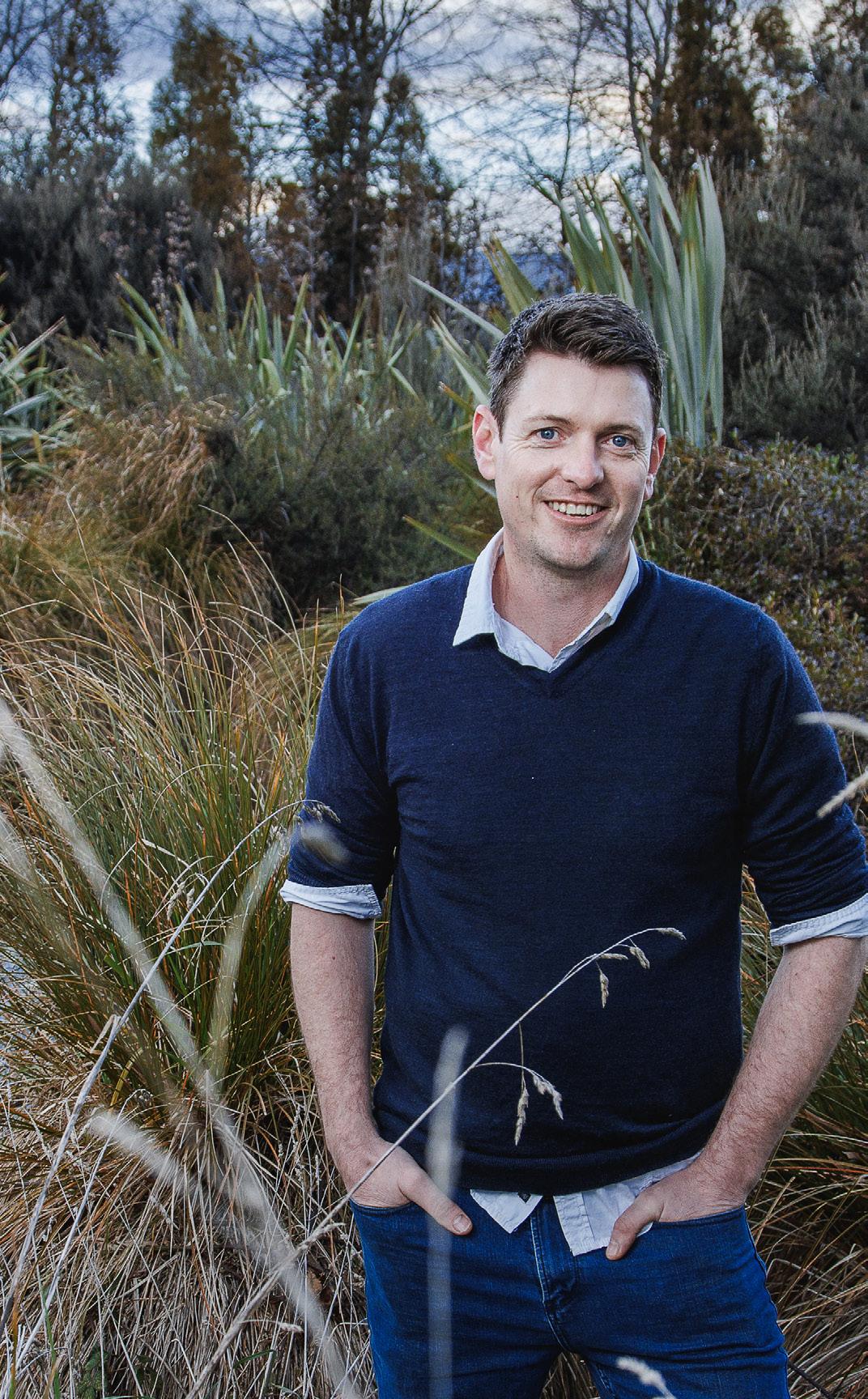


They also have a trap line, which has already taken out 125 pest predators, “the benefits of which have been huge, with the regular occurrence of newly hatched wetland birds, tui, bellbird, grey teal, and groups of up to 25 pukeko surrounding the area most days. There has also been a marked increase of frog population which can be heard during early summer chirping away happily.”
The planting days are a continuation of the “legacy” of the company, which was founded in 1988 and in 2006 was certified carbonzero, a global frontrunner in reducing emissions for carbon neutral wines. It remains a champion for sustainability, with solar energy, New Zealand recycled glass bottles, and sugar cane labels to reduce its impact, Zahn says. “It’s all tied in. There haven’t been a lot of stones that haven’t been turned over in terms of being sustainable and environmentally respectful.”
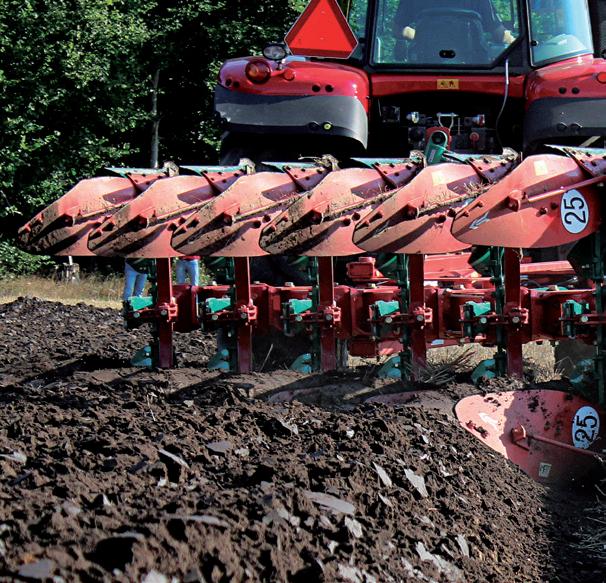
That continued when Foley Wines bought in in 2012, so when Zahn joined the company as cellar foreman in 2019, his planting plans for this “fantastic ecological site”, fell on receptive ears. “It’s very much a passion of mine outside of work as well as inside… And I somehow managed to squeeze it into my job description.”
Zahn says Grove Mill’s sustainability focus has always made the brand special, including for ‘ma and pa investors’ in Foley Wines, which is listed on the New Zealand Stock Exchange. “They’re associated with a brand doing something for nature and the environment.” It is also good news for a team clearly excited by the opportunity to make a difference. “You are a kaitiaki of a really special part of Marlborough.”
SOPHIE PREECEZahn Webb-Thompson. Photo Jim Tannock
“You are a kaitiaki of a really special part of Marlborough.”
Zahn Webb-Thompson












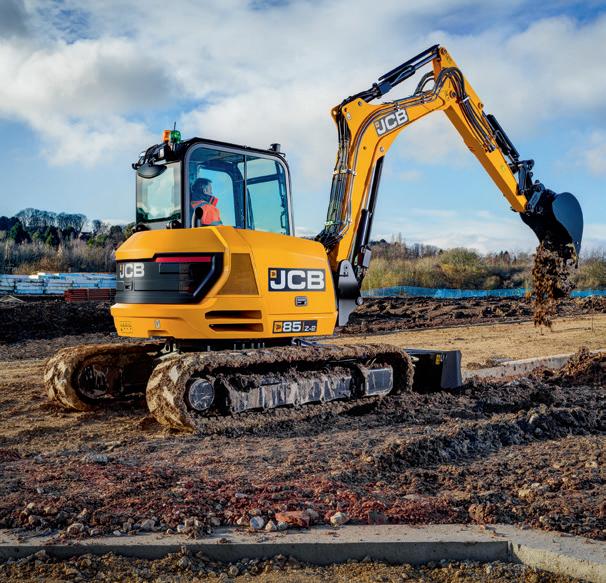









NO TWO wine journeys are the same. Some people follow a linear pathway towards their winemaking ambitions, while others stumble across the industry almost by accident, fall in love and never leave.
Framingham cellar hand Estefania (Stef) Suarez is one of those freespirited folk who followed her nose into the industry, getting her first taste of winemaking as a vintage cellar hand for Kim Crawford Wines in 2014. Ten vintages later, Stef has decided winemaking is more than a passing interest and is cementing her decadelong industry experience with a Degree in Viticulture and Winemaking.
It will take her five years of parttime study to complete the qualification, but after working for many different Marlborough wineries, she feels like she’s exactly where she wants to be at Framingham. “It’s my happy place,” Stef says. “We’re a small team, so I get to do a little bit of everything from vineyard work to the winery, so it’s never boring.”
She’s learning a lot along the way. “It’s quite nice to see the wine’s journey from the vineyard to the final product. Watching the grapes grow, then bringing them into the winery at harvest and turning them into wine, it’s very special.”
When Stef first arrived in New Zealand with a group of university friends in late 2009, it was for a three-month working holiday. But after the devastating magnitude 8.8 earthquake struck her home country, Chile, in February 2010, she decided to extend her working holiday rather than return home and attempt to finish her studies through the recovery and continuous aftershocks. Falling for a Kiwi electrician in Blenheim may also have contributed to her reluctance to return home.
She returned to Chile eventually to complete her Degree in Hotel Management, then raced straight back to New Zealand after graduating. With her degree in hand,
she worked a number of jobs in hospitality and tourism in Marlborough, but it wasn’t until her entrance into the winemaking industry in 2014 that she felt a sense of belonging. “I instantly loved it, I learned about winemaking as part of my degree, but I’d never experienced it firsthand before. Winemaking is much more interesting in real life than on paper.”
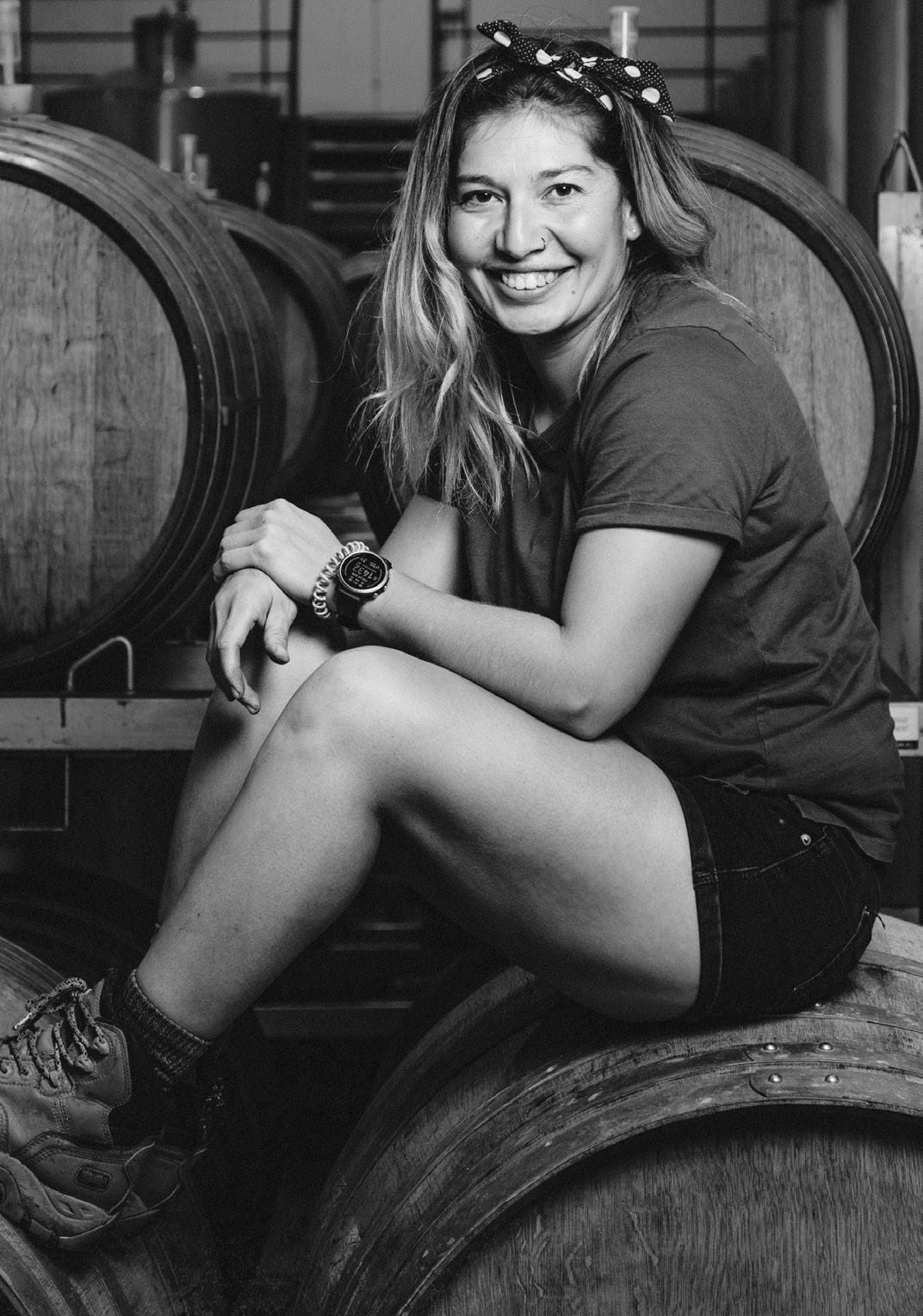
Stef worked for a range of wineries – large and small – before picking up her dream role at Framingham. Seeing wine travel from vineyard to bottle is akin to being a parent watching your children grow up, she says. “You get to see every milestone, from the vineyard when they are just starting out in life, to when they reach maturity and come into the winery, crushing, fermentation, aging, blending and bottling. Seeing our label on the shelf is a proud feeling.”
Returning to study is a big challenge for Stef who loves her dogs and working out at the gym.
“It’s hard to juggle everything but it’s good to be focused on study,” she says. “I never thought I would spend so much time in the library - how lucky the new library is such a beautiful space - it’s my second home now.”
“You get to see every milestone, from the vineyard when they are just starting out in life, to when they reach maturity and come into the winery, crushing, fermentation, aging, blending and bottling.”
Estefania Suarez
• Commercial & Industrial Electricians

• Automation & Control systems
• Winery Upgrades
• Winery Design & Build
Phone: 0274 497 689
Email: admin@electratech.co.nz
Website: www.electratech.co.nz

SUPPLIERS OF:
n Vineyard posts & strainers
n Quality timber products
n Utility buildings - designed for your needs
n Locally owned
n Working towards the betterment of Marlborough
TOP DEALS / TOP SERVICE
163 Hammerichs Road, Blenheim
Ph 03 578 0221 Fax 03 578 0251 sales@rapauratimber.co.nz
FOR ALL YOUR REGEN VINEYARD SERVICES

GROUND AERATION

SPECIALISED DIRECT DRILLING
CRIMP ROLLING
MATT RYAN 021 865 232
PIP RYAN 0274 865 232
CALL

WHEN HORTICULTURAL consultant Murray Neal started digging into soil moisture data in 1987, he had plenty of support from several pioneering wine growers in Marlborough. Nearly four decades later, and 20 years after the company became Fruition Horticulture in September 2003, those early adopting companies are still key clients of the business, says managing director Greg Dryden.

Murray worked for the Ministry of Agriculture and Fisheries, and in 1987 convinced the organisation to buy a neutron probe he could use to assess soil moisture in the rapidly expanding wine industry. “It was the same time the grape industry was starting to take off,” says Greg, noting that leading growers like John Marris, Willie Crosse, Ivan Sutherland, and David and Maree Leonard were early adopters, eager to ensure they were irrigating efficiently by better understanding how much water was required and when.
Murray grew the services under the Agriculture New Zealand banner, and Greg joined the business in 1997. By the time it was rebranded as Fruition in 2003, “growth was astronomical”, with the workload expanding by 20% to 30% each year, Greg says. “It was a really important time, with the grape industry growing. We were growing with it. That’s been really exciting.” In 2005 Jim Mercer joined the business as manager and consultant responsible for the Marlborough region, with Murray taking a change of career.
While growers tend to be far smarter with irrigation now, in those early days it was not unusual to see up to 40% reduction in water use. “Over time growers have become more efficient so the big changes are not quite so big, but we still do get new growers coming in who do reduce their irrigation, especially in the shoulders of the season.”
Soil moisture assessments still make up around half Fruition’s business, with technology now allowing for soil moisture readings every 15 to 30 minutes, delivered to a phone or PC. “It gives them essentially the drinking speed of the plant or transpiration stream of the vine on a continual basis, so they can see how much stress the vine is under,” Greg says. The information also informs growers as to where the roots are active, so water is not wasted in areas beyond the vine’s capacity to tap into it. Greg says the primary goal of efficient use of the water resource is the same as it was when Murray delved into vineyard soils in the late 80s.
“They can see how much stress the vine is under.”
Greg DrydenSOPHIE PREECE







WINEPRO NZ is set to unite wine enthusiasts, industry experts, and professionals, says organiser Gary Fitz-Roy. “Attendees will have the chance to explore the latest products and trends, expand their knowledge, and forge valuable connections within the dynamic New Zealand wine sector.”
Gary says the event, which will run in Blenheim from June 25 to 27 next year, has been “wholeheartedly embraced” by New Zealand’s wine industry, with key personalities offering to drive the education segment, with workshops, masterclasses, and panel discussions on a wide range of topics, covering everything from viticulture and winemaking techniques to marketing and distribution strategies. Meanwhile leading suppliers, producers and innovators are throwing their support behind the event, with its tagline ‘Vine to Wine’.
WinePro will showcase the latest products, including new technology and trends, with opportunities for industry members to grow their networks, their efficiencies and their business opportunities, Gary says. “The WinePro NZ event promises to be a landmark affair for the New Zealand
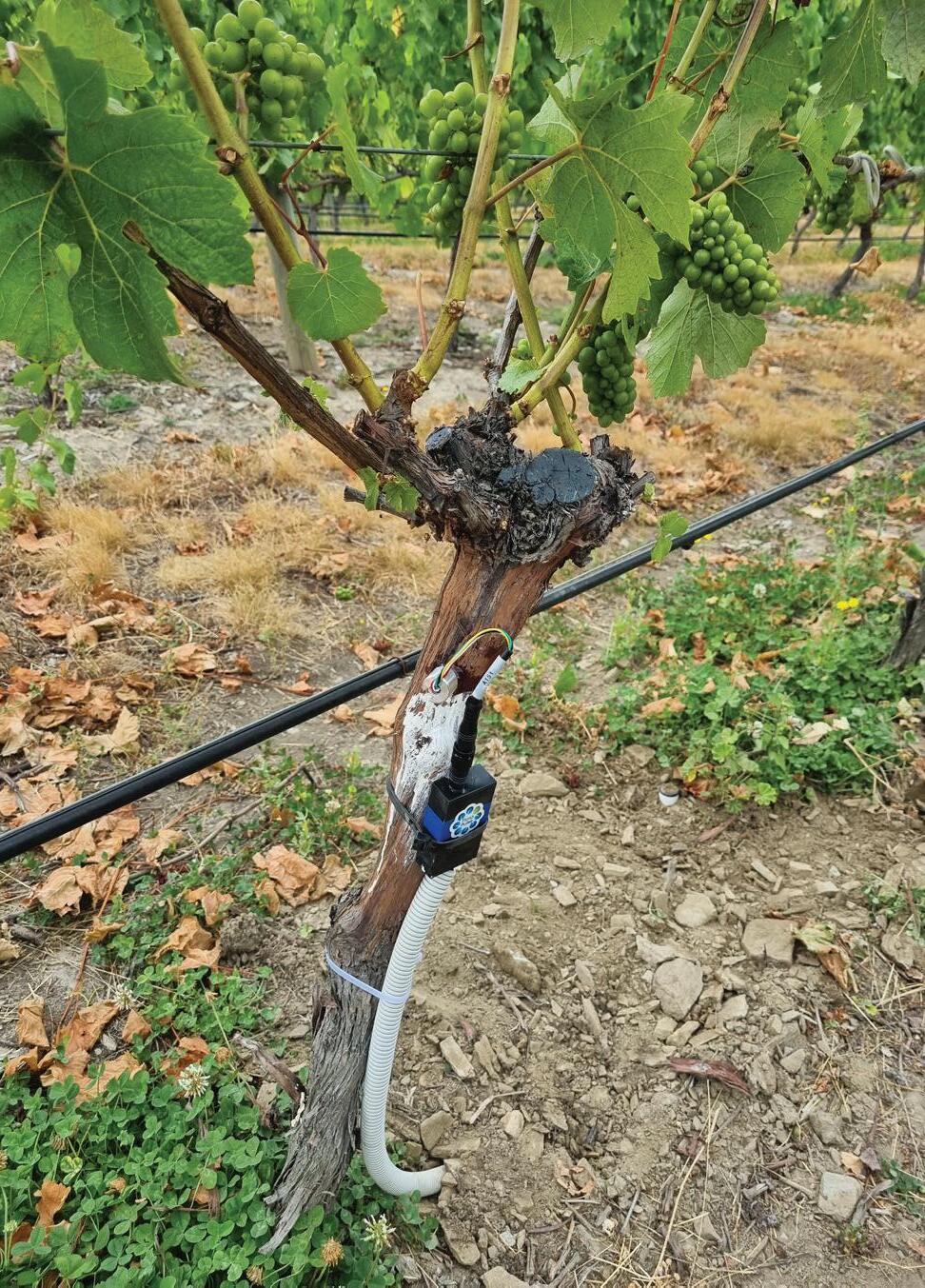



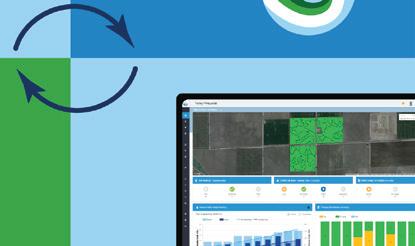
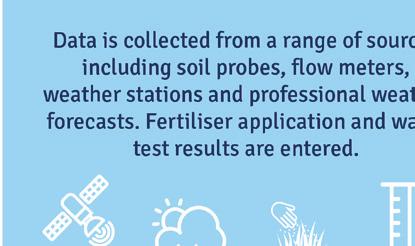


wine industry, featuring the first major exhibition that will showcase products from the entire country.”
Tracy Atkin, who is a start-up advisor and chief executive of private equity firm Marlborough Capital, is part of the WinePro organising committee. “This will be an incredible forum to learn from each other and from international visitors about different ideas, new technology, and developments, as we continue to grow our cool-climate wine industry,” she says. “This is an incredible window to the world, to not only show-case our premium wine styles, but also to convey our sense of passion, pride of place and dedication to sustainability.”
“This is an incredible window to the world, to not only show-case our premium wine styles, but also to convey our sense of passion, pride of place and dedication to sustainability.”
Tracy Atkin



RESILIENCE – IT’S the ability to respond and adapt quickly to disruptions or significant unplanned changes that could threaten your operations, people, assets, and brand. Resilient businesses are better equipped to handle unexpected challenges and are more likely to emerge stronger from them.
Resilience in people is how well we’re able to cope, adapt or ‘bounce back’ when we experience hardship or trauma. Resilient people:
• Embrace challenge
• See effort as a path to mastery
• Grow
• Learn from criticism
• Find lessons from successful people
• Persist in the face of setbacks
Over the past six months in the North Island, New Zealand Winegrowers (NZW) has observed resilience in its most simplistic and kindest way. We have seen the importance of partnerships and good relationship management in crisis situations; the coming together of communities, industries, local support agencies and local wine associations, all working toward a common purpose and ‘getting things done’.

Gisborne and Hawke’s Bay were on the verge of harvest 2023 when Cyclone Gabrielle struck. Grapes were ripe and ready on the vine, bridges had been washed away by large volumes of water and slash, homes were lost, and people were left homeless. Throughout this, our growers and the wider community demonstrated their resilience, and out of the chaos came heartwarming stories, videos, and photos, including partially filled gondolas being brought across a fast-running river, and fuel and supplies being taken across rivers to those who were stranded.

Property owners who had been spared the onslaught of Gabrielle took people into their homes, offering refuge. Subregion emergency centres were set up by locals, where
shattered communities came together and had time out to have a yarn and collect food, drinks, and other supplies.
I AM HOPE were quick to respond in the Esk Valley at Linden Estate and set up a hub that offered all the above, as well as a counselling service for the community. In the Esk Valley I met a group of retirees from the local Summerset retirement village, who had in previous years helped during harvest. This year, instead of harvesting they were cleaning bottles of wine in the cellar, doing what they could to get the business back on its feet.
That’s a snapshot of how resilient people were or how resilient they became in an event that stretched everyone. No-one could have been fully prepared for the force of Cyclone Gabrielle and the devastation it left in its wake.
When an event like this occurs, how equipped are you to manage the impact within your business? What procedures do you have in place onsite that can be stood up immediately to assist your business?
An emergency plan is a health and safety requirement. Investing time in emergency planning makes good business sense; it helps keep you, your workers, your business safe and minimises downtime. You can’t plan for every kind of emergency, but you can be prepared for scenarios most relevant to your situation. What will you and your staff do when disaster strikes?
It is especially important to plan for sudden events that may occur with little to no warning or time to prepare. Here are some emergencies you will require a plan for — some may be more of a threat to you than others.
• Natural hazards: Biosecurity incursion, earthquake, flood, tsunami, volcanic eruption or ash, landslide, tornado or high winds, fire, extreme weather, such as drought or major storm.
• Health emergencies: Workplace incidents, hazardous substance events (for example a chemical spill), medical emergencies, public health event (including pandemics), violent people, animal attacks, epidemics.
• Utility failures: Electricity outages, IT outages, water supply issues.
Risk identification and mitigation of risks makes your vineyard or winery more resilient. Looking at your business and your location will highlight the risks you face at work. A risk is the possibility of something bad happening. Risk involves uncertainty about the effects/implications of an activity with respect to something that humans value, often focusing on negative, undesirable consequences.
Thinking about your own vineyard/winery, where do you feel most exposed? Think about a risk that you know exists, a risk that you don’t have time to assess or implement control measures for, and that has potential to harm you, your workers, and your business.
We need to assess risk, prioritise, and then evaluate the risk, determining the risk’s overall likelihood of occurrence combined with its overall consequence. Control the risk, develop a plan to mitigate the risk by using specific controls – a hierarchy of controls. Assign roles and responsibilities; develop scenarios; place assembly points in your vineyards in the event of an emergency. You need incident planning and flexibility – back-up planning is critical – and you must build in redundancies.
New Zealand’s isolation and climate have protected our vineyards from most of the potentially devastating grape pests and diseases that affect other wine producing nations. With more than 41,000 hectares of grapes in production (and more planned to satisfy increasing demand) and our international connections increasing, the biosecurity risk to our vineyards has been heightened.
Annual completion of the Biosecurity Vineyard Register enables NZW to maintain an accurate record of vineyard locations, varieties planted and planting density. This is important so that in the event of a biosecurity incursion NZW can communicate quickly and effectively with members who may be impacted.

It is critical that New Zealand vineyards are fully prepared to respond to any biosecurity incursion that has the potential to threaten the industry. Biosecurity is crucial for the ongoing sustainability of our industry and decisions made at the vineyard gate are imperative in protecting your vineyard’s biosecurity. NZW strongly recommends all vineyards have a biosecurity plan in place to mitigate the risks posed by new pests and diseases. It has produced a range of factsheets and other resources to help you ensure your vineyards are protected against biosecurity threats. For any questions or further information, please contact the biosecurity team at biosecurity@nzwine.com

Wine legend Oz Clarke is the keynote speaker at the upcoming New Zealand Winegrowers Wine Business Forum at the Christchurch Town Hall. The November 1 event has been designed to advance understanding of the importance of brand to continue to cement the global premium position of New Zealand Wine. Brand experts, leading wine industry commentators and trade will present during the day, and attendees will explore case studies of brands making an impact. The Wine Business Forum will be followed by the 'Altogether Unique - A Celebration' in the evening. nzwine.com/marketing/events
The inaugural New Zealand Wine Centre Scientific Research Conference will be held on November 14. The one-day conference in Blenheim will highlight scientific grape and wine research from universities and research organisations across New Zealand, as well as international research. The line up of speakers includes Dr Marco Hofmann, a professor of viticulture at Geisenheim University in Germany, who specialises in vineyard water balance modelling under climate change scenarios. Attendees will also hear from Dr Jason Smith from Charles Sturt University in Australia, a researcher specialising in grapevine physiology, and specifically carbohydrate balance and vineyard water management. The event will provide a forum for researchers, post-graduate students, and industry technical specialists to meet and connect, increase research awareness, encourage collaborative opportunities, and showcase leading New Zealand grape and wine research. The day will wrap up with a gala dinner. mrc.org.nz/nzwc-scientific-research-conference
A South Marlborough Ecological Corridor project could provide “ecological connectivity”, says New Zealand Landcare Trust Marlborough catchments coordinator Wendy Sullivan. An event on September 14, scoping support for a coordinated corridor effort, will include a talk from Dr Colin Meurk, a landscape ecologist with 40 years’ experience in grassroots environmental action and research. Wendy says by working together, groups already involved in riparian planting and ecological protection could find a ‘community of practice’ for support, through networking, online discussions and workshops. The project could also provide additional justification in funding applications for restoration, and provide facilitated and organised working bees, she says. The Ecological Corridor Project for South Marlborough scoping workshop is on September 14, from 3:30pm5:30pm, at the Events and Sport Centre, Renwick. For catering, please register with wendy.sullivan@landcare.org.nz
New Zealand cellar doors are a step closer to being able to charge for tastings, after the Sale and Supply of Alcohol (Cellar Door Tasting) Amendment Bill passed its first reading with broad support from across Parliament. The bill, which was proposed by Kaikōura MP Stuart Smith MP, would allow wineries holding an off-licence to charge for tastings, not currently allowed by current legislation, which is “out of date”, says New Zealand Winegrowers chief executive Philip Gregan. “It either forces wineries to give wine away for free, or forces them to go through significant cost and time to acquire and maintain a separate on-licence.” NZW welcomes the opportunity to explain its views at the Select Committee, Philip says. “We will be inviting our members to submit directly, and to tell the committee how these changes would affect them.”


Rapaura Springs Garden Marlborough will delve into regenerative agriculture this spring, with a workshop with the UK-based Land Gardeners. Bridget Elworthy and Henrietta Courtauld spoke at the 2019 Garden Marlborough event and are returning to discuss regenerative agriculture and soil health on November 9, introduced by Rapaura Springs viticulturist Matt Fox.
Bridget and Henrietta are currently working with the Althorp Estate in West Northamptonshire to create a soil hub researching the best ways of feeding farm soils without the need for chemicals. Their research is taking them around
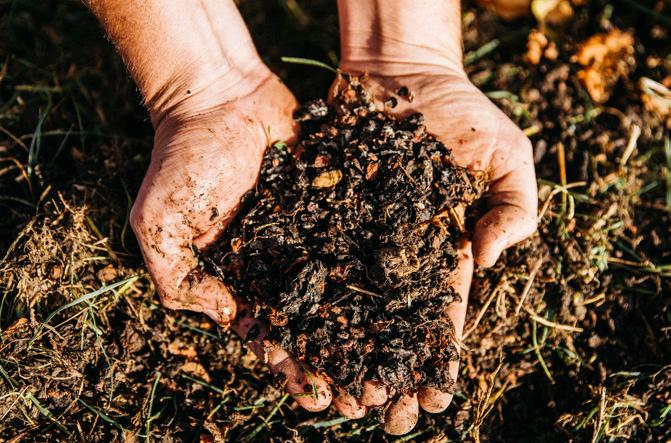
the world looking at ways of restoring soils, including incorporating biological amendments and compost, and under-planting with cover crops.
Matt says there’s increasing interest in regenerative agriculture among winegrowers, reflecting dedication to “the long-term sustainability of our industry and health of our soils”. Rapaura Springs uses cover crops as well as a range of different inputs into the vineyard to bring biodiversity, says Matt. “We repurpose our wastewater for irrigation, use our grape marc for building organic matter in our soils, and utilise our other winery waste into high-carbon resources that are used back on the vineyard. We also have sheep and cattle grazing that are a part of adding to the greater biodiversity of the vineyard and wider property.”
He says it is encouraging to see so many people experimenting with regenerative agriculture in their vineyard settings, “which is only beneficial from what I can see”. Regenerative agriculture and soil health workshop; Thursday November 9, 2pm – 4pm gardenmarlborough. co.nz/workshops/the-land-gardeners
Women in Wine New Zealand is holding a national networking event on November 2, to coincide with the Altogether Unique New Zealand Wine Industry Celebration on in Christchurch on November 1. The Women in Wine event will be held at Kate Sheppard House and is

a great opportunity “to connect and feel inspired”, says national coordinator Nicky Grandorge. All New Zealand Winegrowers members are welcome. More details and tickets available nzwine.com/en/events
Sugar Loaf Wines is a multi-award winning winery situated on Rapaura Road in Marlborough.
We have a specific client winemaking program with additional capacity of up to 500 tonne available for the 2024 harvest and beyond.
We are looking to partner with clients in the 150-500 tonne range.
- Tank Capacity ranges from 3000L – 60,000L
- Red Winemaking and Barrel Storage
- Small dedicated and hands-on winemaking team
- Organic certified production available

- Own harvester and transport for seamless harvest logistics
Please contact cullen@sugarloafwines.co.nz to arrange a winery visit or phone 021 558 558 for further details.





To have your event included in the October 2023 Wine Happenings, please email details to sophie@sophiepreece.co.nz by September 20. For more information, please go to the website supplied or email sarah@winemarlborough.nz
SEPTEMBER
13 Tonnellerie de Mercurey Marlborough Young Winemaker Competition 2023 (nzwine.com/en/events/young-winemaker)
14 Ecological Corridor Project for South Marlborough – scoping workshop (see page 34)

15 Marlborough Winegrowers board election – voting begins (Marlboroughwinenz.com/about)
18-24 Organic Wine Week (organicwinenz.com)
25 National Workforce Survey roll out (see page 14)

OCTOBER
2 Marlborough Winegrowers board election – ballot papers due back by midday
3 Marlborough Winegrowers board election – results notified

5 - 6 Aotearoa New Zealand Chardonnay Symposium (hawkesbaywine.co.nz/symposium)
18 Cawthron Environment Awards Field Day with Repost, 2023 wine industry award winner. Register at info@cmea.org.nz

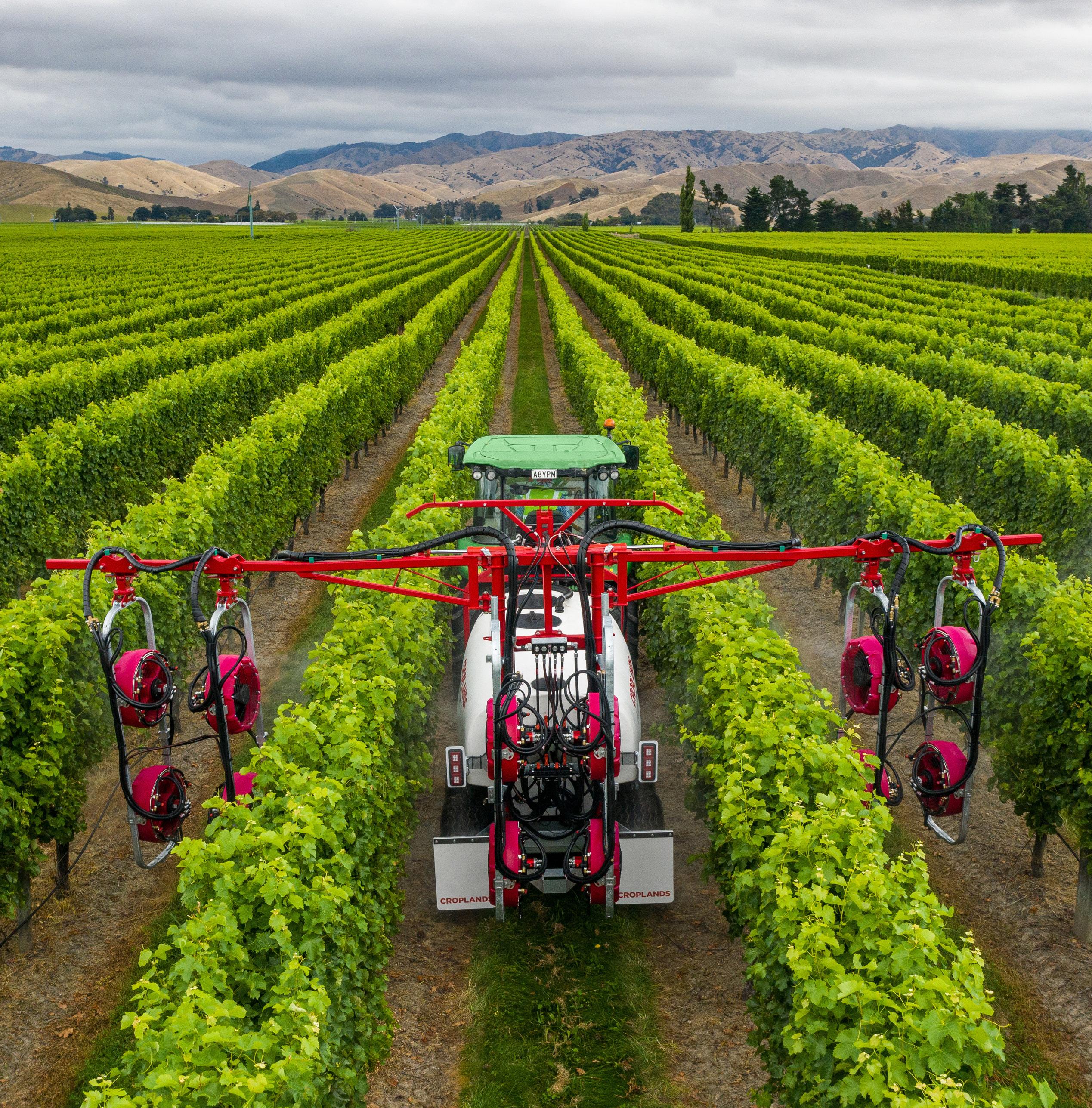
Now building, servicing
Jeremy

18-20 Marlborough Wine Show, Sponsored by QuayConnect, Judging (marlboroughwineshow.com)

20 Marlborough Wine Show Industry tasting
31 Tonnellerie de Mercurey New Zealand Young Winemaker of the Year National Final
NOVEMBER
1 New Zealand Wine, Altogether Unique - A Celebration, Ōtautahi Christchurch (nzwine.com/members/events/workshops)
8 Marlborough Winegrowers AGM
17 The Marlborough Wine Celebration - Honouring 50 years (see page 13)


For more than 100 years, Fruitfed Supplies have worked closely with growers, suppliers and industry bodies to support the success and sustainability of the viticulture sector.


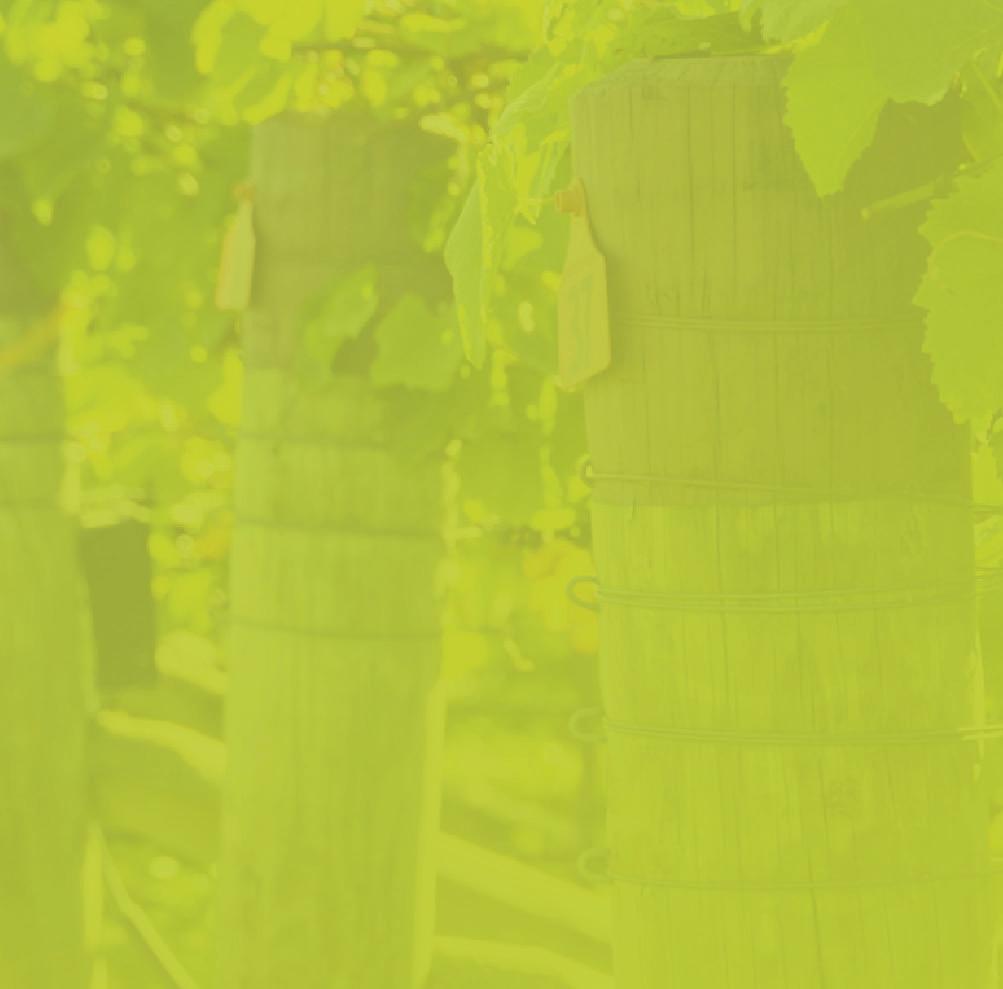
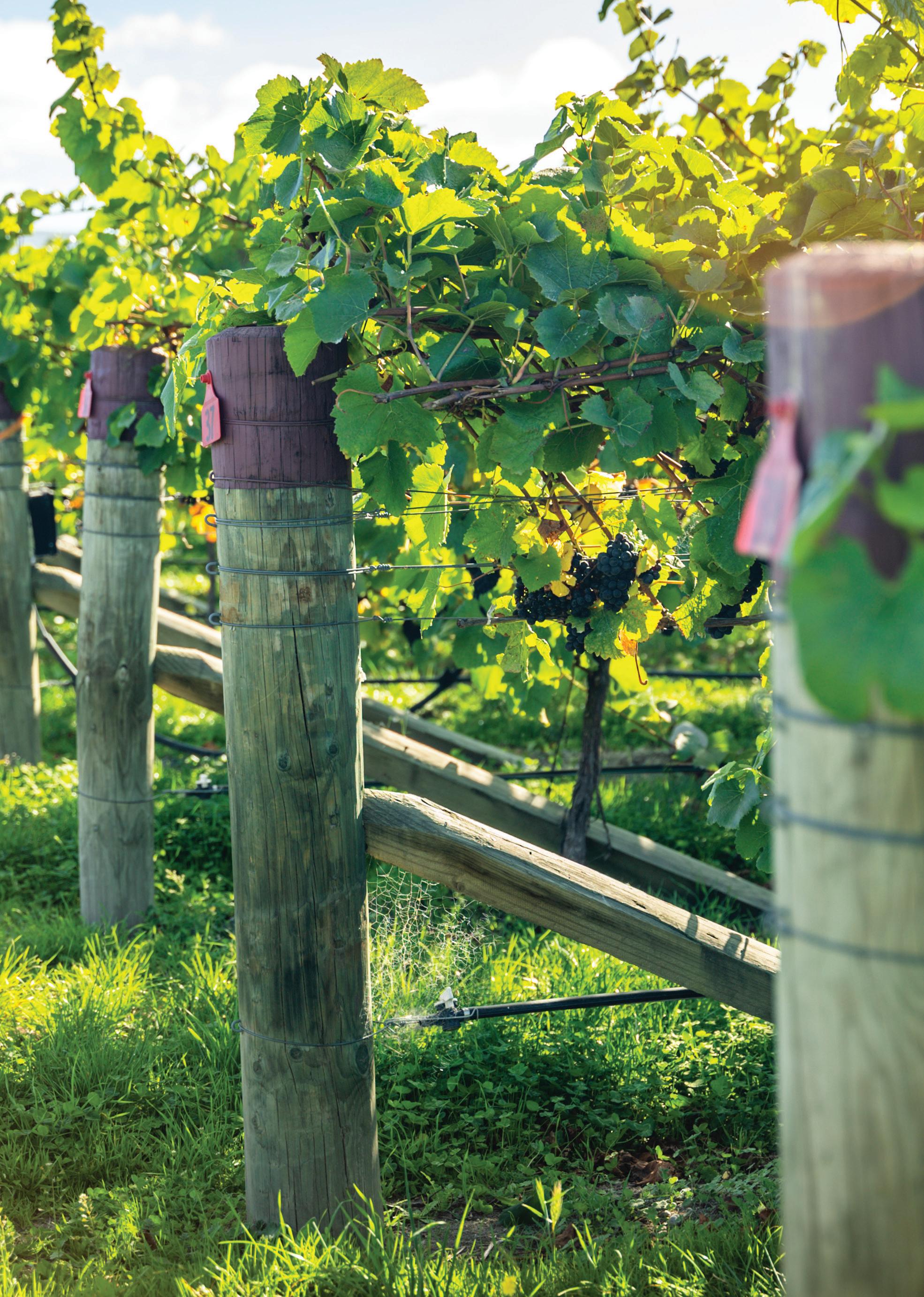
Our stores stock a wide range of supplies for both conventional and organic wineries including:
> Dry goods & enzymes

> Cleaning products
> Fermentation & filter aids
> Yeast & sugar
> Fining products
Contact
www.fruitfedsupplies.co.nz

